Education
- Details
- Written by: Quintus Potgieter
The Engineering Institute of Technology (EIT) has alumni from over 40 countries and is one of the only institutes in the world that can boast a truly global spectrum of learners due to its online student body. However, EIT also has two campuses in Australia that are ready and able to welcome both local and international students for on-campus studies in 2021.
The COVID-19 pandemic has caused a delay in international students traveling to Australia. Encouragingly, EIT has the ability to allow students to stay abreast of their studies while waiting for travel restrictions to lift due to its unique, refined, online delivery model. EIT has been conducting and perfecting online engineering education for the last ten years. The Engineering Institute of Technology has therefore remained open throughout the year without disruption, and is offering future on-campus students an option to begin their studies online and finish the qualification on campus in Australia when borders re-open.

The Engineering Institute of Technology has two campus locations in Australia (Perth & Melbourne) and is planning to announce more in the future. The unfortunate reality that COVID-19 has presented international students who wish to complete their degrees on-campus in Australia with are the travel restrictions that have been enacted. However, at EIT, we have over ten years of experience with delivering high-quality engineering education to students around the world via our unique delivery model. For on-campus studies, we currently cater for both bachelor’s and master’s students.
Bachelor of Science degrees in Industrial Automation, Electrical Engineering, Mechanical Engineering, and Civil and Structural Engineering are EIT’s undergraduate programs available for on-campus study in Perth, Western Australia. EIT also offers Master of Engineering programs in the same fields in both Perth, Western Australia, and Melbourne, Victoria.
EIT’s future on-campus master’s students have been able to commence their qualifications via a unique September intake. These master’s students will complete one unit online and then transition to the campus once travel restrictions are lowered.
The benefit of completing one of the units of the master’s degree online will assist students in becoming accustomed to the unique delivery model EIT employs. They will also become immersed and engaged in their academic journey. By the time they reach the campus, they will be ready to hit the ground running.
The Engineering Institute of Technology is monitoring international travel regulations extremely closely. In the event that travel restrictions are still in place for our February 2021 intake, both the bachelor’s and master’s degrees will continue fully online.
Transitioning from online to on campus
Once travel restrictions are lowered, EIT will be welcoming students with open arms. We recently hosted a discussion with one of our master’s students who is currently completing his Industrial Automation qualification through EIT. Felix Okoh is a Nigerian student who went from studying through EIT’s online campus in his home country to relocating to Australia. He is one of our revered master’s students who has taken the option of completing his course on-campus.
In 2018, Felix was looking for a premium education provider that would further build his skills based on his prior experience. He finished two units in his hometown before deciding to open up a world of opportunities by completing his qualification in Western Australia.
“With my experience in the oil and gas industry in Nigeria, combined with a Bachelors in Electrical and Electronic Engineering, I decided Industrial Automation was one of the fields that would keep me competitive within a wide range of industries,” Felix explained. “I chose EIT because of their specialization in Engineering, more affordable tuition fees, and the accreditation of its programs.”
Felix says that he was at first worried about combining full-time work and part-time online studies, but was quickly impressed by the knowledge of the lecturers and how seamless the learning environment worked for him. After successfully receiving his VISA, he managed to relocate to Australia to complete his studies.
“The online platform affords you a lot of flexibility,” Felix said, “But I decided to go on-campus because I read up a lot about Australia and the opportunities the country has. For students who have studied in Australia for two years and above, you can apply for post-study work rights that let you work in Australia.”
Once Felix commenced his studies in Australia, he explains he enjoyed the campus environment and meeting the capable lecturers that he had become so accustomed to on the online platform. He has made friends with other international students on campus and says that he is building a network of colleagues now that he knows he can rely on in the future.
“I am looking forward to having Australian work experience and being admitted as a member of the prestigious Engineering Australia. I encourage students to look into EIT and work toward improving their careers,” Felix concluded.
You can follow in Felix’s footsteps when you apply for an on-campus bachelor’s or master’s degree with the Engineering Institute of Technology.
- Details
- Written by: Quintus Potgieter
The Engineering Institute of Technology (EIT) is a unique global institute, delivering online engineering short courses, diplomas, and degrees. Students around the world log into EIT’s synchronous online virtual campus to network with other students and lecturers in real-time. Underpinning this live online academic delivery are EIT’s Learning Support Officers (LSOs), who play a key role in helping students succeed in their studies. They become a student’s trusted advisor and provide guidance and encouragement on a student’s learning journey.
“We are the dot connectors for everything a student needs to complete a qualification or course,” said Holly Ross, an LSO based in New Zealand. Holly has been working with EIT for the last seven years, watching the institute grow from strength to strength. “I have gone from seeing our systems and procedures changing rapidly with the growth of the company and the ever-changing world of technology.”
Learning Support Officers walk alongside students every step of the way as they progress in their course. They constantly check-in with their students and iron out any problems the students may be having. If a student is falling behind, the LSO gently (and virtually) nudges the student to help them progress successfully in their studies.
How it all starts
“My role starts once a student has applied for a Professional Certificate or an Advanced Diploma course. I have specific courses that I manage, so if a student applies for one of those courses, their application comes through to me by email,” explains Thelma Bango, an LSO operating out of the South African EIT office. “I then assess the student’s application for suitability, and I either send them an acceptance email in the course or a request for more documentation to support their application.”

Once students are fully enrolled in the course and begin working to earn their qualification, their various studying styles emerge. The Learning Support Officers face the task of keeping tabs on EIT’s diverse student body. Holly says she tries to encourage students at the start of their courses to take it ‘one step at a time.’
“During the course, we check student progress. We contact students who are falling behind and send them letters stating where they need to catch up. Most would normally do their part to ensure they catch up when they get these letters,” said Isabel Sibanda, an LSO based in Zimbabwe.
For diligent students who more effortlessly rise to the challenge of their online qualifications, LSOs give sprinkles of praise to further encourage them to keep pushing forward with their course. In some cases, students are doing their first online qualification, which may seem like a daunting task, but with EIT’s LSOs, their journey becomes easier. EIT Learning Support Officers understand all too well that many students combine their studies with full-time work and they are well experienced in providing the necessary support to assist those students in staying on track.
“The beauty of our work is that we understand that our students have work, family, and life commitments, so we give them an option to ask for an extension to their assignment submission dates, within reason, of course,” said Thelma.
Across the universe
The Learning Support Officers of the Engineering Institute of Technology assist students from an assortment of countries across the globe, including but not limited to: Canada, the United States, United Kingdom, India, South Africa, New Zealand, and Australia.
“Dealing with students from different cultures, nationalities, and continents reveals just how different people are even though the common goal is the same; to attain a qualification with which one can better themselves,” Thelma said.
The Learning Support Officer also experiences news-making world events that unfold and affect their students’ lives. Sisipho Phakamisa, another of the LSOs in the southern African region, explains that she has learned perspectives from students who this year have experienced Australian wildfires, COVID-19, retrenchments, marriages, births, and everything else in between.
Moreover, the LSOs have to be acutely aware of the various time zones students are in. “I have become accustomed to the time differences between students. As big and far away that the continents and countries are, the interaction with students makes the world feel a little smaller,” Sisipho says.
When a course has run its course
Once a course is on the cusp of being completed, the LSO team at the Engineering Institute of Technology encourages students to reach that finish line. Once the students have graduated from the course, they are in charge of putting together the students’ graduation packs. The pack includes their stamped qualification they just earned.
“At the end of each course, I am tasked with the wonderful duty of graduating students from the intake by compiling and mailing out their graduation packs. There is no greater feeling than graduating your class at the end of an 18-month journey and knowing that someone has an additional qualification under their belt, all thanks to your assistance throughout the course,” said Thelma.
While the LSOs wield much power, students are also encouraged to provide feedback surveys to comment on whether or not they are satisfied with the support they are receiving. Keeping students on track is important work, and takes a balance of compassion but also firmness. The Engineering Institute of Technology’s Learning Support Officers are continually refining the processes they employ to help students achieve their dreams. With this ‘art of support,’ LSOs help students earn a career-changing and life-changing qualification.
- Details
- Written by: Quintus Potgieter
Lighting design brings together art and science: requiring the designer to apply both creative, visually appealing, and effective spaces. Lighting professionals work in a variety of roles and project areas: malls, hospitals, residences, roads, tunnels, sports arenas, and more. The Engineering Institute of Technology (EIT) is offering a 52856WA - Advanced Diploma of Illumination Engineering and Lighting Design, starting in November, that will equip students looking to go into the lighting industry with the fundamentals of illumination and lighting.
Lighting also happens to be essential for crop-growing in greenhouses, which in turn, helps geographical regions develop food security. The growth lights industry has been gaining momentum in the last couple of years as urban farming gains in popularity.

Specialists in the lighting industry are in demand, with farming companies looking to build the best lighting designs to produce bigger harvests. Growth lights are a critical component of the urban agricultural sector in colder countries that lack the hours of sunlight much warmer countries get. The growth lights market is expected to grow at a Compound Annual Growth Rate (CAGR) of 19.5% in the next five years, according to a report by Mordor Intelligence. The industry is well suited for an influx of lighting specialists to continue transforming the sector with new and exciting lighting technologies.
With a rescheduled Olympics happening around this time next year, lighting engineers will be working around the clock to ensure the opening ceremony impresses with fascinating lighting displays. Equally important, stadium lighting allows athletes to operate during the evening hours and keep television audiences enthralled and entertained. Lighting specialists are crucial in this area.
The health sector is also seeing renewed interest in lighting specialists too. Considering how many people may have visited hospitals in 2020, lighting designers have been a vital component in making hospitals more welcoming and habitable for patients. According to HealthDesign.org, 11 academic studies suggest that light is ‘effective in reducing depression.’ Other studies found that facilities with low light levels saw more agitated patients. Hence, well-thought-out and designed lighting systems in hospitals can help keep patients and staff psychologically satisfied — and can lead to better patient wellbeing statistics for hospitals in general.
The International Labour Organization agrees that lighting in all workplaces, regardless of industry, is exceedingly important. The organization says that poor lighting at work can lead to eye strain, fatigue, headaches, stress, and accidents. Lighting specialists measure light levels in LUX - luminous flux per unit area. A bright sunny day measures at 100,000 lux. The general lighting standards for a standard office setup is 500 lux. A good mix of natural lighting and artificial lighting is the delicate balance in a workplace a lighting specialist can help create.
To become a specialist in the lighting design field, you can complete EIT’s 52856WA - Advanced Diploma of Illumination Engineering and Lighting Design, which runs for 18 months. The course will introduce students to the following fundamental elements of illumination engineering and lighting:
- Implementing and utilizing engineering solutions to lighting design and illumination engineering.
- Analysing, planning, designing and providing lighting solutions.
- Preparing complex technical information and concepts to plan, communicate, and implement solutions to a range of illumination engineering and lighting design environments and contexts.
- Designing advanced lighting systems utilizing software and understanding of lighting concepts.
- Managing complex projects and tenders on time and within budget.
- Managing self-autonomy to achieve objectives within organizations that have output based on engineering application and develop professional practice in the field.
Becoming a certified professional in the lighting industry is good practice as the industry continues to innovate in the space. With the arrival of the Internet of Things, interconnected lighting systems with remote control and sophisticated automation is creating new opportunities and diversifying the industries where lighting systems can operate within. Now is the best time to update, or even begin your upskilling in the illumination engineering and lighting industry.
Works Cited
“GreenPower LED Production Module.” Philips, www.lighting.philips.com/main/products/horticulture/products/greenpower-led-production-module.
“Impact of Light on Outcomes in Healthcare Settings.” Impact of Light on Outcomes in Healthcare Settings | The Center for Health Design, https://www.healthdesign.org/chd/research/impact-light-outcomes-healthcare-settings
International Labour Organization, www.ilo.org/.
Market Research, www.reportlinker.com/p05934721/Grow-Lights-Market-Growth-Trends-and-Forecasts.html?utm_source=GNW.
- Details
- Written by: Quintus Potgieter
Lifelong learning is imperative for an engineer. Sometimes it is thought of as an informal process consisting of collecting small skills after university graduation and applying them to whatever the engineer's daily tasks are. While that may be true, continued professional development within the industry you are working in is crucial too.
In an ever-changing world transformed by technology, there are vital skills to amass in a way that complements your career and employability as technology continues to reshape the industry. Luckily for the full-time employed engineering professional, upskilling can be done swiftly. The Engineering Institute of Technology (EIT) provides intensive three-month Professional Certificates for professionals in engineering fields. The best part is that the short courses can be completed online and part-time through EIT's unique delivery model. This allows students to continue to grow their engineering skill-sets and develop their careers.
EIT is aware of the constant advancement and rapid automating of industry and is continuously upskilling engineers to meet the requirements of these ongoing developments. Companies that engineering professionals may have been working all their careers for have likely begun automating portions of the business. As a consequence, those engineers require a crash-course in automation. EIT recently hosted a webinar to introduce keen lifelong-learners and industry professionals with some options in the continued professional development realm.

Dr. Akhlaqur Rahman, a specialist within the Electrical and Mechatronics fields who is based on EIT's Melbourne campus, outlined what the institute offers and what value upskilling and future-proofing skills can have for a professional in the engineering industry. EIT's professional development courses are set up in a way that reflects the engineering industry's current needs; of skilled professionals with up-to-date theoretical knowledge.
"Professionals need to keep up to date with the changes that are constantly happening in industry. With the arrival of the age of the internet, everything is moving at such a fast pace. Even if you've got a degree, in five years, there will be something new you need to know in the industry. That is where the professional certificate comes in. We help you rapidly come to grips with what knowledge and skills the industry requires today," said Dr. Rahman.
The advent of the internet and the arrival of industrial automation saw the implementation of concepts that were once foreign and rarely found in historical engineering programs. This has led to already experienced engineers seeing the need to sharpen their skills to keep up with these developments. EIT is constantly working to reach some of the corners of the newer engineering world. The content and theoretical knowledge of the new-school is what professionals may be lacking.
"If you are hoping to go into an industry but only have 50% of the skill-set from a previous degree and you require the other 50% in an unfamiliar role, you need to update your skills. Through EIT's integrated learning approach, you can get that other 50% so that you can not only be exposed to the new concepts in an industry you are venturing into, but also shine in that role," Dr. Rahman explained.
While some professionals may feel like they have been dropped in the deep end of the new concepts in engineering, they should not fret. EIT has a network of 300 lecturers with substantial industry experience. Plus, even before the coronavirus pandemic converted traditional class-based lecturers into online lecturers, EIT's lecturers have cultivated the synchronous online engineering education system for more than a decade.
"EIT is not limited to the lecturer's location. We have highly qualified and experienced instructors really from anywhere in the world. They can share their knowledge and their skills with students equally right around the world. It's important to note that our lecturers are not just qualified; they have extensive experience in the industry as well," said Paul Celenza, the College Manager at EIT.
EIT delivers over 25 Professional Certificate Courses spread across the various engineering disciplines. The courses are three months in duration but designed to fit around the schedules of the attending professionals — factoring in the time zones of students around the world. In five to eight hours per week, professionals can grow and recalibrate their knowledge to the many facets of the industry they are currently working in, or a field they are looking to journey into. The academic benefit for professionals enrolled in the courses is that they combine a unique approach to both theoretical and practical studies.
"EIT utilizes virtual and remote labs — the latter with real engineering tech connected to the internet, ready for engineers to manipulate. We want to give you industry-standard access to software. Students can complete practical exercises using the combination of remote and virtual labs. You are getting industrial environments simulated in the labs. Students have reported that they felt like they were physically in the lab when using it — the simulations to them felt real," Dr. Rahman concluded.
Equipped with a Professional Certificate of Competency short course from EIT, professionals will have increased job satisfaction along with the expansion of knowledge within their field.
- Details
- Written by: Quintus Potgieter
Online learning suits self-starters and people who really want to learn, but it can be a challenge because students need to have discipline and self-motivation in establishing effective learning and study methods. As we launch into a new financial year and, for many, a new academic semester, it is time to review, revisit, and refine your approach to learning.
When looking for methods of learning to improve your retention of new concepts and academic results, it is important to consider tried and tested methodologies alongside new ideas. Gamifying studies, decluttering a work/study space, creating mental pathways for recall, and trying out new time management methods are effective strategies in ensuring your academic success.

Learning How to Learn
Barbara Oakley is an American Professor of Engineering at Oakland University and McMaster University who delivers courses providing practical advice on tackling daunting subjects and developing learning practices related to science, technology, engineering, and mathematics. She is most famously known for the “Learning How to Learn” course that she co-created with Terrence Sejnowski and the University of California, San Diego. Over 1.8 million students have taken this course on Coursera. Alongside her book, ‘A Mind for Numbers,’ it outlines three steps (or tips) to develop higher learning.
Her first tip is Create Mental Scaffolds: Develop mental imagery or analogies when tackling concepts in your study material.
“Sometimes, the analogy or metaphor is rough — such as the idea that blood vessels are like highways, or that a nuclear reaction is like falling dominoes. But these simple analogies and metaphors can be powerful tools to help you use an existing neural structure as a scaffold to help you more rapidly build a new, more complex neural structure.”
Barbara’s second tip is to process information with conscious thinking and unconscious processing to expedite the learning process. This is an interval training approach that involves intense, short periods of focus, followed by relaxing. The method is similar to the Pomodoro method featured in this article.
Her final step includes retelling what you have learned to friends or family (or simply reciting it to yourself) to see if you can explain it enthusiastically and in an informed manner.
Effective time planning
Something else that can keep the mind sharper is a healthy balance of work, play, and relaxation. Focusing on the task that is at hand and getting a good amount of rest could all be efficiently timed and managed with something as simple as a kitchen timer. The Pomodoro Technique has long been touted as an effective studying technique. The idea came about in the late 80s and advocates for interval-led task completion, all made possible with a tomato (pomodoro) kitchen timer. Francesco Cirillo, the creator of the renowned time-management ideology, outlines how the technique works:

- Choose a task you would like to get done (like studying)
- Set the Pomodoro kitchen timer for 25 minutes
- Work on the task until the Pomodoro rings
- When the Pomodoro rings, put a checkmark on a paper
- Take a short break
- Every four rounds take a longer break.
The idea, Cirillo asserts, is to work smarter and not harder. Cirillo says over 2 million people have already used the Pomodoro Technique to transform their lives, making them more productive, more focused, and even smarter.
Gamify your studies and form habits while doing it
Both children and adults are receptive to virtual games. Gamifying your studies turns something that could be perceived as boring into an exciting challenge. Find a way to make your studies interactive and compelling, such as making a conquerable game with levels or a leaderboard. This could further motivate you to complete units in a module or complete a daunting task.
Installing flashcard apps and other memory-building apps could further strengthen your retention and comprehension of information. The packaging of complex information packaged in a way that a visual learner can understand could help a student grasp the information in a more nuanced way. Gamification is becoming a favored way of learning a new language, of learning how to invest, and perhaps could turn into a way to help engineering students prepare for assessments.
Some online commenters on social media site Reddit say that they gamify certain aspects of their life through utilizing an app named Habitica. The app’s tagline is ‘Gamify your life.’ The app purports to motivate you to finish tasks and form productive habits in both work and home life. Here is a video of how it all works:
A clean, functional learning space
An uncluttered studying space is vital. A dedicated space that serves as a comfortable space where you can learn new concepts and serenely take in information is important. Experts report that an uncluttered space is important for mental wellbeing and can help with retaining information. Cluttered space, cluttered mind, is the basic concept. Engineers are sometimes the worst offenders when it comes to clutter. If you have no uncluttered spaces, it might be time to do some spring cleaning and declutter for peace of mind.
Psychologist Alice Boyes Ph.D., writing for Psychology Today, explains in 6 points why a decluttered space is optimal for students:
- Decluttering creates a sense of confidence and self-efficacy (seeing yourself as competent)
- Decluttering is energizing
- Cleaning and organizing reduce anxiety
- Decluttering allows mind wandering and (sometimes) involves physical activity
- Decluttering can reduce relationship and family tension.
- When you declutter, you often find lost treasures.
Changing the way you learn and developing new ways of processing and remembering information could further prepare you for the unexpected. Learning new concepts could impact your work in a positive way. New study methods and personal development methodologies have been growing legs during the pandemic, which may continue in certain regions. Thus, teaching an old dog new study tricks could help during this uncertain period. Gamifying studying methods, decluttering your work/study space, and learning how to manage time more efficiently are just some of the ways students are carrying on as uncertainty reigns.
Works Cited
Boyes, Alice. “6 Benefits of an Uncluttered Space.” Psychology Today, Sussex Publishers, 12 Feb. 2018, www.psychologytoday.com/za/blog/in-practice/201802/6-benefits-uncluttered-space.
“The Pomodoro Technique® - Proudly Developed by Francesco Cirillo: Cirillo Consulting GmbH.” Cirillo Company, francescocirillo.com/pages/pomodoro-technique.
- Details
- Written by: Quintus Potgieter
The Engineering Institute of Technology will soon be rolling out a new flagship Professional Doctor of Engineering qualification for engineering professionals looking to contribute to the development of their specific engineering disciplines. We are proud to announce that Australia’s independent national quality assurance and regulatory agency for higher education, the Tertiary Education Quality and Standards Agency (TEQSA), has approved the Engineering Institute of Technology’s Professional Doctor of Engineering for delivery in 2021. EIT’s doctorate provides engineering professionals the opportunity to solve a problem or develop an improvement to an engineering challenge in their employment.
Students will soon be able to apply for the Professional Doctor of Engineering and take a leading role in the research and development of the specific industries that they are involved in - with the assurance that they will be professionally recognized as Doctors of Engineering upon completion of the program. The Engineering Institute of Technology now delivers programs for the entire academic journey of technicians, technologists, and professional engineers from short courses, diplomas, bachelor’s, and master’s degrees, through to professional doctorate-status.
 Creating innovative solutions to technological problems in society is what engineers are constantly aspiring to do. However, some engineers find themselves deeply embedded in academia and yearn to innovate and perform practical innovations in industry. The EIT Professional Doctor of Engineering (DEng) will allow engineers to be able to make original and significant contributions to the development, application, and evaluation of professional knowledge by engaging with practical problems of demonstrated importance to their employment context and the wider body of engineering and technical knowledge. Successful completion of the program will equip graduates to take a leading role in the development of research investigations into current and future problems of industrial and community concern within their area of expertise. The program will give candidates the skills and experience to act as independent researchers or group leaders for investigations of practical importance in their professional area over their professional life.
Creating innovative solutions to technological problems in society is what engineers are constantly aspiring to do. However, some engineers find themselves deeply embedded in academia and yearn to innovate and perform practical innovations in industry. The EIT Professional Doctor of Engineering (DEng) will allow engineers to be able to make original and significant contributions to the development, application, and evaluation of professional knowledge by engaging with practical problems of demonstrated importance to their employment context and the wider body of engineering and technical knowledge. Successful completion of the program will equip graduates to take a leading role in the development of research investigations into current and future problems of industrial and community concern within their area of expertise. The program will give candidates the skills and experience to act as independent researchers or group leaders for investigations of practical importance in their professional area over their professional life.
Who should apply for EIT’s Doctorate?
The Deputy Dean of the Engineering Institute of Technology, Indumathi V, says she is looking forward to seeing what kind of professionals apply for the Doctor of Engineering. Professionals with four-year bachelor’s degrees and significant work experience or a master’s degree in engineering may be eligible to apply for EIT’s Doctor of Engineering program.
“Australian and international professionals in pretty much any engineering industry can apply. If you are from construction, transportation, manufacturing, power, mining — you name it. They could even be a person who is perhaps working in an engineering consulting firm, and might be seeing a recurring engineering problem they are trying to solve,” she said.
Prospective students from countries outside of Australia, who are keen to study and ultimately work in Australia, can begin work on their Doctorate via EIT’s unique online methodology in their home country and have the option of applying to transition to an EIT campus in Perth or Melbourne.
Indumathi is currently pursuing her Ph.D. on the topic of Engineering and Education at the University of Southern Queensland. Her research work includes looking at how institutes can combine technologies to assist students and teachers in the learning environment. Her expertise in this field will be translated into the EIT Professional Doctor of Engineering delivery methodology.
Why should you apply?
EIT’s Doctor of Engineering program is unique in comparison to a traditional Doctor of Philosophy, which is particularly academic research focused. In contrast, EIT’s doctorate centers around applied research and allows students to make a significant and original contribution through innovative problem solving, engineering design, and analysis, furthering the professional practice.
Upon completion of the doctorate, the engineer will have gained skills and knowledge that will further enable them to perform technical investigation, apply their research, and develop solutions to the problems they have set out to grapple with. A Doctor of Engineering qualification will also open up new opportunities for employability within the engineering industry. It is the highest academic award in engineering, and the Doctor of Engineering gives formal recognition to engineers, enhancing their professional standing.
Another benefit of pursuing EIT’s Doctor of Engineering is the program’s cost-effectiveness. When compared with the traditional cost of a Ph.D., EIT’s solution presents a unique opportunity for passionate engineers who are looking for a new way of acquiring their ‘doctor’ status.
This program is highly recommended for engineering professionals who have a passion for engineering and want to contribute to the profession through original contribution of knowledge within the context of professional practice. It can include engineering professionals from any engineering field.
Please register your interest by
- Details
- Written by: Quintus Potgieter
As a passionate educator, EIT’s Dean, Dr Steve Mackay, never underestimates the benefits of a good quality education. When a career path and an individual are aligned he knows the sky is the limit. Engineering and technology are the focus of EIT, but so too are those who yearn to work in a field of endeavour that inspires and drives them every day.
This is the story of a young South African man who, with has his heart set on farming, is achieving his dream. Asanda Mnguni is the one with the vision, but he is being supported by his indomitable mother, Nomsa (Gloria) Mkhwanazi, a gifted farmer, Ms Gitti Kraupner, and the Engineering Institute of Technology.

Asanda is 21 years old and studying away from home, but during college holidays he lives with Gloria, a single parent, a house keeper and part-time carer of the frail and elderly. They live at the foot of the magnificent Drakensberg Mountains, in Himeville - a tiny village near Underberg. Whilst the region is known for tourism, it is also known for its farming communities.
Himeville also happens to be where Steve Mackay’s wife grew up. Asanda explains, “Steve and Edwina started supporting my mother when I was still a child because of our poor living conditions. The year was 2006, and my mother was unemployed at the time. We have been receiving their support ever since.”
Building an agricultural future
Asanda is in his third year of a Diploma of Agricultural Management at Cedara Agricultural College. He says his future in agriculture looks bright because he is receiving support from local commercial farmers who are allowing him to gain practical experience on their farms and it is helping him gain the necessary skills needed within the farming sector.
“Growing up in a farming community made me consider agriculture as a possible career choice. I may be one of the first black farmers within my community once I have completed my studies,” Asanda says proudly.
During South Africa’s Covd-19 lock-down, Asanda has been working on an Aquaponics project on Gitti Kraupner’s farm in Himeville. The Aquaponics project is a new addition to the farm – the farm typically specializes in cattle breeding.
Aquaponics is a system of aquaculture in which the waste produced by farmed fish, or other aquatic creatures, supplies the nutrients for plants grown hydroponically (without soil) and in its turn purifies the water.
In drought prone regions many South African farmers are beginning to view aquaponics as a viable farming alternative and it is being considered a means to producing food for impoverished communities. Asanda notes that an aquaponic ‘farm’ can be started in the smallest of backyards and retailers have the necessary equipment for a start-up.
About the project he is involved with, Asanda explains, “We have constructed the whole aquaponic system from scratch. Advantages of this system include reduced water wastage, increased production per square meter and an organic way to produce food when compared with traditional farming methods. This approach will help feed the growing population and meet the future demand for food.”
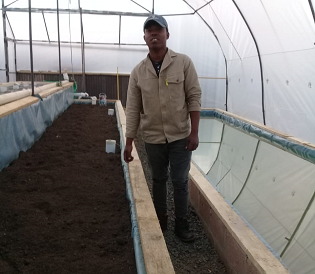
Asanda is passionate about the future of agriculture in South Africa and wants to see a turn-around in the economy where 29% of South Africa’s population are unemployed.
Asanda concludes, “In the next 5 to 10 years I really want to see myself on my own farm implementing all the knowledge I have learned while studying, and the skills I’ve obtained from farm experiences. I really hope to inspire the youth - not to think of agriculture as a rudimentary job in society, but to understand the importance of farming, especially in rural areas where most of the youth can grow their own wealth without having to search for it in cities where employment can be a challenge.”
All of us at EIT are very proud of Asanda. He is dedicated to his studies and has taken advantage of the practical farming experiences offered to him.
Steve Mackay remains in awe of EIT students and alumni who draw on their education and entrepreneurial skill to support their communities. It is this sense of social responsibility which inspires EIT to do the same.
It was clear that all Asanda needed - to make his way in the world - was determination, an opportunity to demonstrate and hone his growing skill, and a little support. We wish him well as he works towards completing his qualification and becoming a fully-fledged farmer in South Africa.
- Details
- Written by: Quintus Potgieter
Dr Arti Siddhpura is one of EIT’s on-campus lecturers and is a decorated academic, holding a Doctor of Philosophy in Mechanical Engineering from the University of Western Australia.
Dr Siddhpura’s engineering journey began in 1996 at the Government Polytechnic University in India, where she earned in Diploma in Mechanical Engineering. In 1996, she enrolled for her Bachelor’s Degree in Mechanical Engineering at Sardar Patel University, continuing on to earn her Master’s Degree in Mechanical Engineering (Machine Design) by 2004.
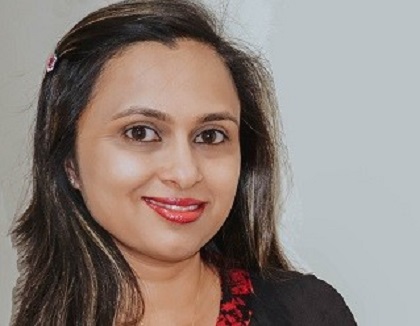
In 2008, Dr Siddhpura made the move from India to Australia, working as a casual academic at the University of New South Wales. However, by March of 2009, she has earned a position as a Research Scholar at the University of Western Australia. It was there that she began work on her Ph.D. in Mechanical Engineering, graduating in 2013. Her research has now been recognized internationally and has been published in several reputable peer reviewed journals.
Dr Siddhpura says her passion to succeed in the engineering world was all thanks to her father, who made an indelible imprint on her life. She now pursues her work with a desire to impart her experience and knowledge on others in the world, helping lead them on the path to a rewarding career in the field of engineering.
“My father sparked my interest in machines and tools as I saw him working on all different DIY projects during his spare time while growing up. After accomplishing a few engineering degrees leading to a Ph.D. in Engineering, mechanical engineering became my passion. I wanted to induce the same interest in others. The only way to do so is through engineering education and training. Hence, I ended up in the field of engineering training and education.”
After several lecturing and researcher positions in Western Australia, Arti joined EIT as an on-campus lecturer in 2019. She now spends her days at our Perth campus molding the next generation of future engineers.
“On a day-to-day basis, my lecturing responsibilities include preparations, lecture recordings, live delivery of tutorial sessions, creating assessments, marking assessments in addition to thinking and coming up with all different ideas to help students understand various engineering concepts,” she explained.
“I am also involved in the review and revision of various higher-education and VET courses and their contents. I coordinate orientation sessions before the semesters begin and lecturer training sessions throughout the year. I am heavily involved in research and scholarship activities and I have published and presented research articles in international conferences around the world.”
Dr Siddhpura says she wants more girls to be introduced into the engineering world at a young age so they can shatter stereotypes and become global leaders in STEM later on in their careers. In turn, she says, women can become role models for others. She encourages women to chase their PhD dreams:
“Earning a Ph.D. in Mechanical Engineering field was the most fulfilling goal of my life as it provided me global exposure while exploring the depth of the subject area and reaching some milestone peaks. Mechanical Engineering is an evergreen branch of engineering, without which nothing can be manufactured.”
“All the machines (from sewing machines to earth moving machines), transport vehicles (cars, ships, planes, and spacecraft) and even all the machines/components used by other engineering streams like electrical/electronic/civil engineering is made by Mechanical Engineers!”
Dr Siddhpura never felt that anything in her career felt too daunting. She never let the stereotypes of the engineering industry get to her and is a shining example of a woman who took the engineering industry by the horns. She is happy to report her personal growth and the institute’s growth since she has joined EIT:
“Personally, I feel that I am growing exponentially with ever-growing new courses at EIT. Each semester since I joined full time, I have been developing and teaching at least one brand new subject, which is a challenging yet rewarding endeavor. EIT has been undergoing a steep trajectory of growth in the last year and is developing heaps of new higher-education courses.”
She notes her excitement for the launch of EIT’s Masters courses in Mechanical Engineering, Civil and Structural, and Electrical Engineering.
- Details
- Written by: Steve Mackay
The Engineering Institute of Technology (EIT) has been providing high quality live, interactive online education and training for over 15 years. EIT’s offerings span the two education sectors, from vocational diplomas through to bachelor’s and master’s degrees in engineering. These qualifications are accredited by the Australian Government, and some of these programs are also recognized under three international engineering accords. EIT also offers practical professional development short courses to help engineering professionals gain specialist skills. At any one time, EIT has approximately 2000 students and reaches them in over 150 countries.
This wisdom, synthesized into six truisms for driving excellence in online education, can be applied to all areas of education and training, not just to students in STEM.

1. Go back to basics to engage remote learners
Teachers must use strategies to increase their presence in the virtual classroom and ensure the learning environment is dynamic and engaging. This should include a warm welcome, an introduction (using a webcam), strong interaction, and concluding each session on a high note. These simple strategies have been measured and do improve student satisfaction and learning outcomes.
To maintain engagement throughout the class, teachers must build high levels of interactivity into each session. They should consider including all the options: learner-teacher, learner-learner, learner-content, learner-interface (such as with a computer) and learner-individual (time out with the student doing their ‘own thing’).
To overcome the psychological and physical distance between the learners and the teacher, immediacy is the key. A teacher should field and drive questions, use student names, provide feedback instantly and allow the odd digression into issues of personal interest.
2. Inflexible is better
Synchronous online learning via web-conferencing creates a ‘classroom’ in which students and the teacher gather in real-time. EIT’s unique online delivery methodology makes live and interactive tutorials, an international pool of expert lecturers, dedicated learning support officers, and state-of-the-art technologies such as hands-on workshops, remote laboratories, and simulation software.
As a model of online learning, it is less flexible, but the benefits outweigh this limitation. It ensures students remain engaged in the learning process, it facilitates interaction and questions, it connects remote learners with each other, and it reduces the notorious rates of attrition evident in asynchronous online courses. Therefore, students are encouraged to advance their technical knowledge and remain engaged in their studies while forming global networks and balancing life and work commitments.
3. Go mobile
The Internet of Things has revolutionized many things, including mobile learning for engineers and scientists. We once had a student attending a session on the train between London and Glasgow, while his teacher presented between the vines in the Swan Valley, during a staff Christmas lunch!
There are many ways in which a phone or mobile device becomes your learning tool; it can be used:
• For communication.
• For assessment.
• For reading data in the environment.
• For undertaking written assignments.
• For social networking.
• For the collection of data.
• For simulation.
• For recording lab experiments (with the camera).
• As a remote control.
4. Virtually ‘physical’ is best with remote online labs
Experiential learning — or hands-on education — is one of the most optimal ways of gaining engineering expertise. Therefore, online learning must accommodate it. The ongoing virtualization of instruments (such as oscilloscopes and signal generators that are controlled and viewed from PCs or tablets) is the impetus for using remote labs. For example, it is common for mining trucks and plant equipment to be controlled remotely; this illustrates that the virtualization of work and equipment is growing apace.
EIT’s remote labs feature physical equipment and sensors equivalent to the traditional university engineering lab. The practicals are interactive, controllable, variable, and viewable over webcams in real-time, with examples including; data communication and protocols, scientific instrumentation, physical experimentation, the control and observation of circuits, systems and machinery, and robotic automation. Students can see the immediate results of their experimentations.
Similarly, EIT’s virtual labs consist of simulation software for a multitude of engineering applications, including modelling and analysis, science education, programming, power network design, construct models, design and drafting, project management, industrial process control, and virtual plant field operations.
Some traditional teachers of engineering remain sceptical; they suggest that remote labs lack authentic, hands-on work. Despite this, learners find a well-constructed remote lab (with a simple interface) useful and equivalent to that of a traditional lab.
EIT Master of Engineering (Industrial Automation) graduate Mildred Nanono found this to be the case.
“EIT’s use of state-of-the-art technology was very, very instrumental and very beneficial. The simulations felt real. It felt like I was physically in the lab.”
Here are some pointers to constructing successful remote labs:
• Build them with a clear understanding that there will be multiple users operating the labs remotely. Using this as a guiding principle will ensure operating glitches are avoided later.
• Employ a scheduling system for the lab users - this can assist with system overload.
• Reduce system response times – they should remain below 150 milliseconds.
• Aim for ‘reality’ - with an easy-to-use graphical user interface.
• Use good lighting.
• Ensure teachers are well-trained and supportive.
• Encourage students to reuse labs to improve their results.
• Use lab work as part of a student’s final grade.
Here are some design principles for the Graphical User Interface (GUI) for remote labs:
• Keep it simple and intuitive.
• Aim for authenticity.
• Ensure multiple users can work together.
• Enable a student to interface with a standard computer (preferably within a browser) with minimal software add-ons.
• Ensure the GUI displays key information swiftly.
• Use plain English.
• Have a quick exit option from unwanted menu selections.
• Standardize interfaces and make them consistent.
• Do not make the steps, within the GUI, necessary to remember.
• Simplify and clarify error messages.
Overall design considerations:
• Experiment type: how will the architecture impact the experiment; multiple users and queuing issues?
• Scalability: how will the system cope when the number of users peaks?
• Maintainability: does it integrate easily into the overall IT services/systems?
• Security: has this been a key part of the design and are secure communication protocols supported?
• Dependence on protocols: does the architecture require a specific protocol?
5. Do it in Teams
One of the greatest advances in education over the past decade has been the implementation of collaborative learning or learning in teams. Capstone projects that are undertaken in groups are regarded highly by engineering regulators.
Successful learning can occur when activities are:
• Performed in a group collaboratively.
• Undertaken in a project setting.
• Based on authentic real work activities.
This can be achieved successfully in the virtual world. Instead of meeting face-to-face, the teams can remain geographically scattered, using telecommunications-based technologies to communicate. Virtual collaborative learning will occur when two or more people work together on an educational project using computers (and the internet) as the interface.
Some advantages of working in teams include:
• An increased understanding and better retention of course materials compared with a classroom-based session.
• An appreciation of the opinions and analyses of others.
• A higher level of critical thinking, analysis, and assessment when working together on a problem involving conflict resolution.
• A higher motivation for learning when part of a group.
• A lower rate of attrition in online learning.
Some disadvantages include:
• Unequal contributions from different members.
• Team instability in the early part of the term, as class enrolment can fluctuate.
• Leadership issues.
Typical activities in a virtual collaborative group:
• Analysing case studies.
• Working on an engineering design.
• Undertaking discussion/debates with synchronous/asynchronous tools.
• Creating and maintaining communities of practice.
Some suggestions for facilitating a virtual team include:
• Focus on specific cases - where there is a possibility of achieving real results.
• Create teams where members have a range of skill sets.
• Simplify projects.
• Ensure communication tools are effective.
• Divide the workload up equally.
• Quieten dictatorial team leaders.
• Ensure all members participate fully.
6. Testing the often untestable
One of the elephants in the room, with online education, is the authentication of students. Who is actually doing the work? Are they enjoying unreasonably high levels of outside support?
Online proctoring software offers a solution; it allows for the remote testing of a student’s knowledge. It ensures the student is properly invigilated, and it can authenticate them. However, a student must accept and embrace this solution and be well-prepared for the proctoring operation before sitting for a test.
For example, EIT’s exams are authenticated by IRIS Invigilation (IRIS). This software program helps provide educators assurance of assessment integrity during online and remote assessment. IRIS records audio, video, and computer screen activity for the duration of a test/exam. It analyses this information using machine learning and automatically flags potential academic dishonesty displaying the data in an easy to use reporting dashboard.
The following issues need to be dealt with in an online examination environment:
• Security: testing on concepts (rather than requesting regurgitated content) heightens academic integrity.
• Interactivity: live, face-to-face tests (e.g., orals) are preferable to online ones.
• Equity: all random questions should be targeted at a similar level.
• Hands-on labs: physical demonstrations can be assessed using screen-capturing software.
• Teamwork: needs to be assessed as it is a key activity of engineers and scientists.
Finally…
Remember that when the technology ‘disappears’ and the student makes seamless contact with their teacher and their peers, you have arrived at a good place with online education.
With changes happening across the world, thanks to globalization and the fourth industrial revolution, the future of employment will inevitably evolve as the internet of things and the internet of systems exponentially infiltrate workplaces. It is imperative that engineers and technicians who are working in the industry stay on top of these changes through continuous professional development.
EIT offers three-month short courses that deliver specialist skills to engineers and technicians that can be immediately implemented into the workplace. These courses focus in on topics such as Machine Learning and Artificial Intelligence, IEC 61850 based Substation Automation, Programmable Logic Controllers (PLCs) & SCADA Systems, Power Distribution, Fundamental E&I Engineering for Oil and Gas Facilities, Gas Turbine Engineering, Heating, Ventilation and Air-Conditioning, and Project Management for Engineers & Technicians.
- Details
- Written by: Quintus Potgieter
EIT recently embarked on a roadshow through southern Africa, covering hot trends in engineering, job prospects across the engineering disciplines, and troubleshooting tips.
Dean of Engineering Dr. Steve Mackay and Edwina Ross presented an interactive seminar on ‘engineering as a noble profession’ to aspiring engineers and industry professionals in South Africa, Namibia, and Botswana.
 In the crowds were EIT alumni, current students, prospective students, and curious engineering enthusiasts. The seminars did focus on the noble profession of engineering and its immutable age-old principles. However, Dr. Mackay also demonstrated how the industry is changing thanks to globalization and advanced technologies.
In the crowds were EIT alumni, current students, prospective students, and curious engineering enthusiasts. The seminars did focus on the noble profession of engineering and its immutable age-old principles. However, Dr. Mackay also demonstrated how the industry is changing thanks to globalization and advanced technologies.
“We are hyper-connected: mobile apps, emails, social media, and a quickly updating web. Analytics and predictive models are appearing. One of the great programming languages is Python. There are incredible tools you can use in your career. Everything is in the cloud; you can derive huge resilience by working under the cloud. If it weren’t for the cloud, we wouldn’t have a college,” Dr. Mackay said.
He noted that engineers are finding employment in a plethora of industries they might never have considered before due to the changing nature of the industry, learning, and training under the fourth industrial revolution.
“Engineering is increasingly driven by technology, and these technologies change rapidly. In response, engineers need to become more versatile. There is downward pressure on repetitive jobs in industry today.
“You have to take ownership of your education and training. That’s why you guys are here because you’re proactive in your learning. We believe that engineering skills are becoming more and more generalistic. Today you have to go cross-disciplinary and become a highly-skilled generalist.”
EIT as a solution to conquering the automation future
“EIT is a creature of the fourth industrial revolution,” Dr. Mackay said. The seminar highlighted EIT’s Industrial Automation qualifications, which have been specially created to conquer the challenges brought about by the technically demanding fourth industrial revolution.
In a wisdom-of-the-crowd practical exercise, seminar attendees were divided into groups to come up with automation solutions for several industries. They had to devise innovative solutions for automating a service station, a pizza shop, and an iron ore mining operation. The exercise demonstrated how cross-disciplinary the engineering solutions are to some of the world’s most complex technological problems. It also inspired the participants to think above and beyond what the role of the traditional engineer is.
The participants displayed immense creativity, which provided a fantastic insight into how the advent of automation has transformed the minds of both working and prospective engineers.
Dr. Mackay encouraged the attendees to explore the development of their critical thinking and investigate becoming shrewd entrepreneurs. His mantra is: “Experience together with life-long learning is critical for your career.”
A plethora of options with EIT
EIT’s College Manager Paul Celenza attended the seminar in Johannesburg, South Africa. He spoke to the crowd about EIT’s many study options to suit students of all different walks of life. He also described the methodology of how the institute delivers its courses.
“We have a whole gambit of different courses we provide to different students. We have live webinars where we link up students with lecturers in real-time. We have academically qualified instructors that have years and years of industry experience. They speak the same technical engineering languages that you do. We are ready to host you and get you fully equipped to thrive in your career.”
 Representatives from EIT travel the world to demonstrate our unique online and on-campus delivery modes. These both make use of live and interactive webinars, an international pool of expert lecturers, dedicated learning support officers, and state-of-the-art technologies such as hands-on workshops, remote laboratories, and simulation software. Students can study online from anywhere in the world, or they can study select degrees on campus in Perth or Melbourne. Our supportive blended learning model and small class sizes allow you to advance your technical knowledge and remain engaged in your studies while forming global networks and balancing life and work commitments.
Representatives from EIT travel the world to demonstrate our unique online and on-campus delivery modes. These both make use of live and interactive webinars, an international pool of expert lecturers, dedicated learning support officers, and state-of-the-art technologies such as hands-on workshops, remote laboratories, and simulation software. Students can study online from anywhere in the world, or they can study select degrees on campus in Perth or Melbourne. Our supportive blended learning model and small class sizes allow you to advance your technical knowledge and remain engaged in your studies while forming global networks and balancing life and work commitments.
On this trip, EIT was seeking to prove to the participants that we can provide them with high-quality engineering education and training. Prospective students were most interested in the EIT programs that are accredited by Engineers Australia and therefore are recognized under international engineering accords.
“Our visit was exceedingly valuable. The African continent is hungry for education and innovation. The continent is brimming with resilient engineers. The region’s technological capabilities have grown by leaps and bounds. More Africans than ever are connected to the internet, and that is ensuring that they can come and study with EIT and fulfill their work responsibilities at the same time,” Dr. Mackay concluded.
- Details
- Written by: Quintus Potgieter
March 8th marks International Women's Day 2020, a global day that celebrates the social, economic, cultural, and political achievements of women. We wanted to take this opportunity to highlight the valuable contributions from women at the Engineering Institute of Technology (EIT) and the movements they are making to break through the glass ceiling.
In 2017, the World Economic Forum released its global figures on women in engineering. They reported that around 20% of engineering graduates are women, but only 13% of the engineering workforce is female. A lot has been done to elevate female engineers in the last couple of years, but there is still work to do. Getting girls ready and prepared for the world of STEM work is one of the major challenges of our time.
Thus, the importance of introducing young girls to STEM subjects at an early schooling level is paramount. We consulted our very own Deputy Dean of Engineering at EIT, Indumathi V, to collect her thoughts on the ongoing challenge of getting more women into engineering. She believes that it is essential for young girls to be aware of the various career options and study pathways available to them.
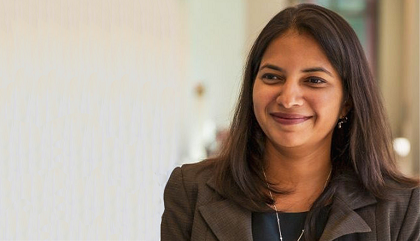
"Education is the foundation to a better society. Engineering is the field that is a pillar in providing economic, environmental, health and security benefits to society. I am a strong advocate for girls and women in STEM. I am encouraged by being a mum of two young girls and a boy myself. It is important that girls are aware of any capabilities that they need to develop from a young age to nurture their interest in the field. I have run some successful initiatives and actively participate in events that promote girls in STEM."
Indumathi is passionate about innovating in the educational space and getting more people educated and trained in engineering. She understands, however, that the prospect of studying towards a career in engineering is a daunting one. Retaining the interest in mathematics in young adults is becoming harder and harder. Indumathi said:
"I was a student who was not very good at maths when I was young. It wasn't until my year 10 when maths started finally making sense, and my confidence grew to pursue Engineering. That making sense led me to understand the importance of a passionate teacher, good pedagogy, good training, well rounded education and how it changed my pathway. Both engineering and education share synergies of making a positive impact on the future generation and society."
Revolutionizing the way education is delivered is necessary to include girls and women, particularly in developing nations, in engineering education and training. Indumathi is currently pursuing her Ph.D. on the topic of Engineering and Education at the University of Southern Queensland.
Her research work includes looking at how institutes can combine technologies to assist students and teachers in the learning environment. After joining EIT in January 2019, Indumathi has helped the institute grow from strength to strength as the institute looks to ways to revolutionize the dissemination of engineering education and training.
"EIT has grown very strongly since I started at the beginning of 2019. Their innovative approach to accessible, flexible, and high-quality education is like no other in the world. The success is strongly attributed to the passionate team of lecturers and staff here at EIT.
"We are always looking at ways to do things better and are very student-centric. While we have a young growing on-campus program, we are growing strongly every day and have achieved some great recognition via professional accreditation of our programs and via our staff and student publication list growing strongly."
Works Cited
Hutt, Rosamond. "Why Do so Many Women Leave Engineering? Probably Not for the Reason You're Thinking." World Economic Forum, www.weforum.org/agenda/2016/11/why-do-so-many-women-leave-engineering?utm_content=buffer43a1f&utm_medium=social&utm_source=facebook.com&utm_campaign=buffer&fbclid=IwAR2z4QcvQV23dIrMlaP1N8l_jSjUUQN0ifpNAfdTgU7xINGywP6qhjHw6sw.
- Details
- Written by: Quintus Potgieter
While the Engineering Institute of Technology has campuses in Perth, Western Australia, and Melbourne, Victoria, we predominantly run as an online institute that sees thousands of students logging in and out every day. For students who are part of our online learning cohort, internet connectivity is imperative.
We are proud to have students from all over the world who have earned Australian accredited diplomas and degrees through our unique online delivery model. We are, however, aware of the challenges many countries face with limited internet connectivity.
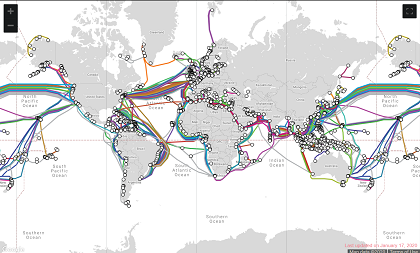 According to Internet World Stats, there are 525,148,631 internet users in Africa. The continent’s population is said to be 1.216 billion people, according to estimates compiled in 2016. About 690 million people are, therefore, without access to life-changing internet technologies.
According to Internet World Stats, there are 525,148,631 internet users in Africa. The continent’s population is said to be 1.216 billion people, according to estimates compiled in 2016. About 690 million people are, therefore, without access to life-changing internet technologies.
In 2017, the United Nations (UN) reported that more than half of the world’s population still does not have access to the internet, with Asia and Africa facing the lowest connection rate. It has now set a goal for universal access to the internet — which would equate to 90 percent of the world population — by 2050.
Facebook and Amazon have been experimenting with the research and development of internet-for-all technologies. Engineers are deeply involved in how nations connect to the internet. While philanthropic companies undertake the challenge of creating new, still-to-be-debuted, mobile internet technologies, the tech that connects the world to the internet has its fair share of maintenance issues.
How is the internet provided to the world?
Ninety-nine percent of international internet data is transmitted through a series of submarine cables spread across the ocean floor across the globe. There are 300 undersea cables transmitting data underwater, ensuring nations get internet connectivity.
However, when these connections become damaged, the internet traffic from the directly affected countries is rerouted through working cables. This impacts speed and accessibility.
For example, on the west coast of Africa, the West Africa Cable System (WACS) and South Atlantic 3 (SAT3) form international links that connect southern Africa to the world.
WACS connects South Africa with the United Kingdom. The SAT3 cable connects South Africa to Portugal and Spain. Both of these cables were damaged by gale winds earlier this year, impacting the entire collection of southern African internet service providers.
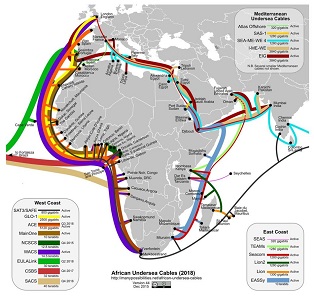
On the east coast of Africa, the SEACOM and EASSy cables are receiving rerouted international internet traffic from the western parts of the country where the cables are down.
This meant internet service providers had to continue buying international bandwidth from SEACOM to keep international traffic ticking along for their consumers.
The future of internet connectivity
Are undersea cables set to be the norm for internet connectivity a century from now? Is South Africa’s cautionary tale of gale-force winds and broken undersea cables enough food-for-thought for engineers to come up with more innovative ways of connecting the world to the internet?
Some internet service providers in southern Africa offer competitively priced high-speed satellite internet. Satellite internet is useful, especially in rural areas that do not have fixed and wireless internet infrastructure. South African born Elon Musk’s aerospace company SpaceX, has recently launched a satellite network named Starlink that will help provide low-cost internet to remote locations.
The U.S. Federal Communications Commission (FCC) has given the company clearance to launch 12,000 small satellites and may allow them to push the number to 42,000 in the future. Around 242 satellites are already in space. Ongoing research and development of internet technologies, such as SpaceX’s Starlink, are going to have to go into hyperdrive to meet the UN’s target of 90% of the earth’s population being connected by 2050.
Works Cited
“Africa Internet Users, 2019 Population and Facebook Statistics.” Internet World Stats, www.internetworldstats.com/stats1.htm.
Mann, Adam. “Starlink: SpaceX's Satellite Internet Project.” Space.com, Space, 17 Jan. 2020, www.space.com/spacex-starlink-satellites.html.
- Details
- Written by: Quintus Potgieter
The Fourth Industrial Revolution has had a significant impact on the worlds of education and work. The advent of the internet and its subsequent development over the last three decades has led to immense changes and has produced incredible technological leaps. The interconnectivity of internet-connected technologies has dually given rise to the Internet of Things. This has meant that a plethora of technologies are now online: household appliances, houses themselves, laptops, smartphones, watches, virtual reality headsets, and virtual assistants.
The development of mobile internet-connected technologies has not only revolutionized consumer technologies, but it has also created a seismic shift in the ideologies that underpin education. The methodology behind remote, online education and training is an ongoing process with the goalposts constantly shifting in the industry.
The focus of the last couple of years in the online education and training space has been on simulation - which has also led to gamification. Gamification is used as a strategy of teaching that relies on creating playable games that teach real-world principles. Simulating engineering problems in gamification environments is particularly helpful for learning practical skills that can be applied in the workplace.
The CEO of Simutech Multimedia, Samer Forzley, recently delivered a presentation at the Process Expo at McCormick Place in Chicago. He convinced crowds that manufacturing floor staff could be taught via playable, simulated engineering games. His presentation was entitled ‘Digitally Developing the Next Generation of Manufacturers with Gamification and 3-D Simulation’. The company has created a point-and-click game that displays a real-life engineering simulation of a manufacturing floor.
Forzley says that the teaching methods that worked for one generation will not work for the next one. He says that Generation X, and their predecessors, the Baby Boomers, learn through memorization and mentoring, otherwise known as a traditional schooling environment. Once these students get to the manufacturing floor, they would receive additional training from staff already employed at the factory. However, he says that the teaching methods of the past are failing to hit the mark with Millennials and Generation Z.
Therefore, simulated virtual environments and gamified engineering problem solving is the new way forward for a generation of people who have grown up in the interconnected internet age. It is also a great way to gain continued professional development and attain new skills and knowledge in different areas of engineering.
The Engineering Institute of Technology (EIT) is an Australian institution that specializes in engineering education and delivers professional development and accredited programs to students worldwide. We use a unique online delivery methodology that makes use of live and interactive webinars, expert lecturers, dedicated learning support officers, and state-of-the-art technologies.
One such technology is our online laboratories and simulation software. They can be accessed by students around the world to simulate engineering scenarios and enhance applied skills and knowledge, so they graduate job-ready.
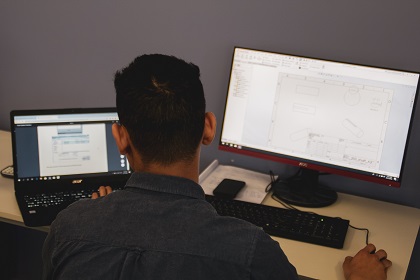
Students can control and interface with a pneumatic circuit using a microcontroller, for example. There are also labs involving field instruments; they include data acquisition, pumps, motors, industrial modems, and routers. Sensors can also be accessed, including flowmeters, ultrasonic sensors, oscilloscopes, and temperature gauges.
However, students learning online also require some real-world practical examples of how engineering workplaces function and what problem-solving scenarios may arise during their employment. Therefore, students can benefit from a process plant simulation that simulates both the operator and field technician roles.
Using plant simulation software, students can ‘walk’ through an industrial plant, tune a process loop, or diagnose a fault. Equipped with the knowledge learned in the virtual-practical world, the students can safely go into their workplaces knowing how to control the technology on-site.
The simulation kits range from compressors, pumps, distillation columns, heaters, and boilers. And they are realistic. With diagnostic tools rapidly becoming internet-based, these simulations are very closely aligned with real-world plants.
Works Cited
Wpengine. “Control Engineering Magazine.” Control Engineering, www.controleng.com/magazine/.
- Details
- Written by: Edwina Ross
Just after returning from presenting a round of seminars in Asia (in India, Nepal and Sri Lanka), Steve Mackay landed in Melbourne on the evening of the 26th November, with three colleagues, for the TEQSA Conference.
The theme at the conference this year was Partnerships driving Quality – a topic close to our hearts: in essence, as educators, we partner with our students. One of our Master students, Santosh Ghimire, based at our campus in Melbourne, attended the conference as EIT’s student representative.
Another important partnership, which helps us drive quality, is the one we have with industry. We engage practicing engineers to guide us in the design of our course content and experienced engineers from around the world instruct and lecture for us. Furthermore, our students complete internships in engineering industries and ultimately our graduates work within them.
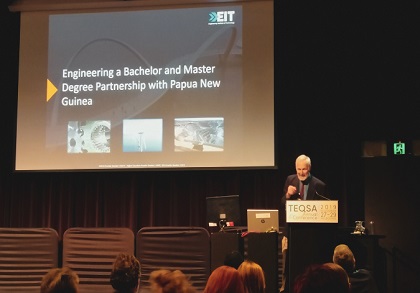
Steve Mackay and our Resources Manager, Danielle Techera, presented at the conference. Danielle’s presentation described the importance of that collaboration with industry, with her focus on its contribution to the creation of our academic resources for students; resources that are relevant, practical and prepare students for real work in their fields of engineering.
Her presentation also described why our materials are designed in-house – rather than relying on individual lecturers for content. Our platform of learning is multi-modal and therefore more complex; a number of lecturers are often involved in teaching a single unit - in higher education, or a single module - in a vocational course. We use industry to design and drive the content, but by creating the resources in-house we can guarantee that the materials are consistent and equivalent across the delivery platforms. It also ensures that our materials are continuously improved; an increasing necessity as engineering becomes more reliant on changing technologies.
Steve spoke briefly about the challenges EIT is facing with transnational education. Towards the end of 2018 an exciting opportunity arose: to work with PNG partners and offer engineering degrees to school leavers. (Engineering graduates are critical to the resources projects that run in the country.) A number of hurdles have presented themselves, however, including some political challenges, but Steve likes nothing more than a challenge. It is likely that his persistence will result in positive partnerships across the Arafura and Coral Seas before long. And more importantly, celebrate the graduation of students who will enjoy fulfilling careers in engineering in PNG.
The conference was an important opportunity to network with the TEQSA team and attendees from across the education industry in Australia. It also gave everyone an opportunity to debate, learn and contribute to issues that are critical in the sector. Some of the topics were very positive, for instance: Creating a Sustainable Culture of Scholarship, and one with which we at EIT staunchly agree: Knowledge as the Key to connecting the Vocational and Higher Education Sectors.
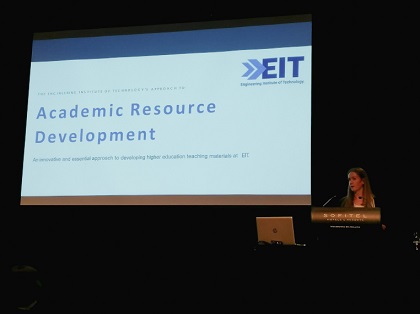
Some of the more dispiriting and threatening issues in education were also broached; for instance how academic integrity is being undermined by contract cheating. The profound extent and impact of unethical businesses which facilitate these dishonest practices was confronting to hear. Thankfully, with its vibrant and established online platform, EIT is prepared and a little ahead in this ‘game’. Our IRIS software (Intelligent Remote Invigilation System) has frustrated many students, just when they thought that ‘a leg-up’ would save them some time and effort!
The conference certainly provided grist to the mill for those who attended and was a fitting end to another successful and eventful academic year at the Engineering Institute of Technology.
We would like to acknowledge the creative and hard work of the incredible EIT teams of academics and administrators scattered globally. And to our wonderful students, past, present and future - based in all corners of the world - we wish you everything of the best as 2019 draws to a close. We thank you all for your support.
- Details
- Written by: Quintus Potgieter
Engineers are the all-encompassing link to most of the world’s observable built environment. They are the backbone of functioning systems all across the globe. They keep the lights on, the water flowing, the robots in sync, the planes in the sky, and much more. So, should you pursue a career in engineering?
Working engineers today will tell you that it is a rewarding career with problem-solving at its core. However, people should get into the engineering industry because they want to further humanity’s progress. Engineering's purpose has long existed to invent new ways of doing things and to continuously increase efficiency. The many technological contributions of engineers throughout human history have transformed the world in which we live.
John Browne was the chairman of L Energy and chief executive officer of BP from 1995 to 2007. That period was known as the ‘golden period of expansion and diversification’ for BP. He received praise for directing the oil company’s attention to alternative renewable sources of energy. He was also the President of the Royal Academy of Engineering from 2006 to 2011.

He is a keen author who makes sense of the engineering world for prospective engineers, encouraging them to make the world a better place through their work. He has just released a new book titled: ‘Make, Think, Imagine: Engineering the Future of Civilization.’ He reckons that humans’ interaction with everyday technology is awakening the engineer hidden inside them. A section of his book reads:
“There is an engineer in every one of us, but we, fortunately, do not require the skills or expertise of a professional engineer to tap into this aspect of our nature — contemporary technologies, such as the Internet and smartphones, give all of us access to an engineering mindset. Now, more than ever, we can use these technologies to solve the world’s problems and shape the society in which we live.”
Engineering is a profession that has traditionally attracted those with an affinity for maths and science. However, the tide is slowly turning to involve more humanities-inspired approaches to engineering.
Bringing new technologies into the world
Engineering has recently been defined as solutions-based problem-solving to replace and automate some of the more repetitive tasks humans engage in. For instance, autonomous vehicles are something many an engineering company wishes it could perfect — that is their idea of progress. However, getting to a finished product has not been easy for engineers.
“Progress is not delivered with an instruction manual spelling out the safe and responsible use of new inventions,” Browne writes.
“Engineering is instead like a game of cat and mouse, in which innovators must continuously act to ensure that the intended consequences of their efforts outweigh the unintended ones.
“Engineered solutions will never be perfect first time because mistakes and misuse are inevitable, and every step forward has risks. Autonomous vehicles will create a revolution inconvenience but, unless properly designed and tested, could kill more people than human drivers currently do.”
Technological progress, while a noble engineering intention, must be first be tested out in a controlled environment so that we can know whether it is feasible. And once its viability can be proven, it needs to be marketed to society and governments at large to show its something the world needs.
Therefore, engineers have to become entrepreneurial. Engineering programs have typically ignored the business side of engineering, but now engineers are seeing that they need to become salespeople of their own innovations to convince the world they need the solution.
“Engineering naturally led me into business, since I realized that no solution was complete unless it resulted in something practical that humanity wanted,” writes Browne.
“Thomas Edison apparently said that ‘anything that won’t sell, I don’t want to invent. Its sale is proof of utility, and utility is success. Engineering is like a head with two sets of eyes: one looks to the fruits of discovery, the other looks to the demands of commerce and customers.”
Being an engineer in the modern world is a balancing act that involves becoming a multifaceted and as skilled as possible. With technology rapidly advancing and automation creeping into industry, an engineer who was eligibe to thrive in the previous industrial revolutions, may not be prepared for the fourth industrial revolution. Hence, engineers must prepare themselves for the new civilization that is already being transformed by the digital revolution and the call to make the world a more environmentally friendly place.
Specialized Engineering Education
The Engineering Institute of Technology delivers engineering programs that are designed by an international body of industry experts, ensuring our students graduate with cutting-edge skills that are valued by employers around the world. Our vocational programs and higher education degrees are accredited by the Australian Government, and we have programs that are recognized under three international engineering accords. Together with our sister organization IDC Technologies, we have trained over 500,000 engineers, technicians, and technologists globally over the last 30 years.
We deliver programs for a range of different levels, from professional development to diplomas and degrees. They are offered across a variety of fields such as industrial automation, electrical engineering, mechanical engineering, civil and structural engineering, industrial data communications, electronic engineering, and engineering management.
We deliver our online and on-campus programs via a unique methodology that makes use of live and interactive webinars, an international pool of expert lecturers, dedicated learning support officers, and state-of-the-art technologies such as hands-on workshops, remote laboratories, and simulation software. Whether you are studying online or on-campus in Australia, our supportive blended learning model and small class sizes allow you to advance your technical knowledge and remain engaged in your studies while forming global networks and balancing life and work commitments.
Works Cited
Bloomberg.com, Bloomberg, www.bloomberg.com/opinion/articles/2019-09-16/engineers-are-the-reason-many-of-us-are-alive
Browne, John. “Make, Think, Imagine: Engineering the Future of Civilization.” Amazon, Pegasus Books, 2019, www.amazon.com/Make-Think-Imagine-Engineering-Civilization/dp/1643132121.
“Careers in Engineering - A Beginner's Guide.” The Engineer, 18 Sept. 2019, www.theengineer.co.uk/careers-engineering-first-steps/
- Details
- Written by: Quintus Potgieter
Technological advancements are changing the landscape of the engineering industry by creating gaps in practical knowledge. As a result, engineers need to educate themselves continuously to keep up with these innovations. This is especially crucial for those working in multidisciplinary engineering companies.
Micro-credentials are the key to helping graduates stay up-to-date with new technologies across the industry. The continued industrialization of the world is creating incredible opportunities in the engineering industry.

It also means that educational institutions need to stay on top of these changes so they can provide appropriate training. It is no longer about just delivering major qualifications, such as degrees and diplomas — it is about providing professional development to engineers in every stage of their careers.
As the industry changes and areas such as automation and cybersecurity become so much more critical, qualified engineers need flexible and high-quality short courses that hone in on these specific areas.
Engineering professionals see digital technologies that can interface with the Internet of Things, and general automation technologies, changing the face of their workplaces rapidly. These engineering professionals are seeking to build on their skillset while honoring their initial qualifications.
The Engineering Institute of Technology (EIT) delivers several professional development courses across different engineering industries. All of these courses are designed by an international body of industry experts, ensuring our students develop cutting-edge skills that are valued by employers around the world. They are kept up-to-date to remain current with rapidly changing technology.
We have a unique delivery model that makes use of live and interactive webinars, an international pool of expert lecturers, dedicated learning support officers, and state-of-the-art technologies such as remote and virtual laboratories, and simulation software. Because we deliver these courses via the Internet, already qualified engineers can gain professional development and form global networks, while balancing life and work commitments. The courses help engineers gain new knowledge in three months, supplementing the skills they already have.
Works Cited
“The Surge in Micro Credentials.” Australian Financial Review, 22 May 2019, www.afr.com/news/policy/health/the-surge-in-micro-credentials-20190521-p51po4.
- Details
- Written by: Quintus Potgieter
In August, the Engineering Institute of Technology (EIT) went to Namibia in southwest Africa to meet with prospective and already working engineers. While there, we hosted a seminar about the trends in the engineering industries that are transforming Africa.
The development of skills amongst young people in Namibia is vital. Therefore, EIT visited the Namibian University of Science and Technology (NUST). We were invited by the Dean of Engineering, Dr Samuel John, to share with the faculty of engineering students what EIT is doing to provide engineers with further tertiary education and training.
In the presentation, David Gadjus, EIT’s International Education Manager for the regions of Africa and South America, shared several pathways to gaining higher education, training, and continued professional development through our institution.
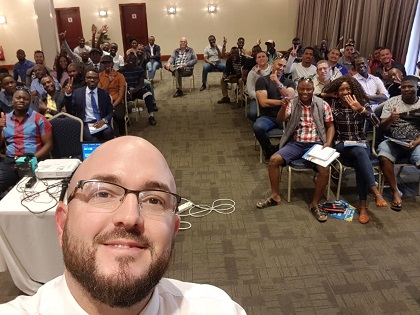
Gadjus says the students were interested to learn about EIT’s online delivery methodologies. Online distance learning is rapidly becoming something students in Africa are becoming interested, since networking technologies have advanced on the continent. Now, mobile internet technologies are becoming the norm, and more students are wondering how they can gain knowledge through online means.
“Many potential students are unable to attend full-time or part-time classes due to family or work commitments. Some also work at remote sites and do not have access to physical education institutes.”
EIT then hosted a seminar at the Protea Hotel Furstenhof in the center of Namibia’s capital Windhoek. David was joined by EIT lecturer Deon Reynders who presented on the technical aspects of the engineering knowledge that comes along with enrolling in EIT courses.
“There were so many people who came to attend that we had to arrange more chairs to accommodate everyone. We had some of our current online students who came, keen to stay updated with what is happening with EIT. We had some prospective future students who enquired about our online and on-campus programs. We even had representatives from the Engineering Council of Namibia, including the Vice President.”
The attendees were seemingly most interested in the area of study catering most to the fourth industrial revolution: Industrial Automation. EIT delivers accredited advanced diplomas, bachelor's degrees, and master’s degrees in Industrial Automation. The prospective students were naturally curious as to what jobs they could apply to when graduating through the Industrial Automation courses. EIT recommends that practitioners involved in the following industries would benefit greatly from pursuing the Industrial Automation qualifications:
- Electrical engineers and electricians
- Maintenance Engineers and Supervisors
- Energy Management Consultants
- Automation and Process Engineers
- Design Engineers
- Project Managers
- Instrument Fitters and Instrumentation Engineers
- Consulting Engineers
- Production Managers
- Chemical and Mechanical Engineers
- Instrument and Process Control Technicians
One of EIT’s Namibian students, Festus Tawii, was also in attendance at the seminar. He told the crowds gathered about his positive experience of studying with EIT. Festus currently works with the country’s energy utility Nampower.
Festus is currently studying the 52726WA - Advanced Diploma of Applied Electrical Engineering at EIT. He told the attendees that he was utilizing the knowledge he was gaining in his course in his day to day job in the energy sector.
All in all, EIT is seeing record numbers of seminar attendees in the Southern African regions. The attendance numbers prove that the hunger for the skills of the future and the mastering of rapidly advancing technological industries are in high demand. EIT is looking forward to returning to Namibia and collaborating with educational institutions on the ground to both strengthen their education sector and open students’ eyes to the possibilities and opportunities they can access that could transform their engineering careers.
- Details
- Written by: Quintus Potgieter
The ability to code in the python language is becoming an increasingly sought-after skill, particularly in the engineering field. In industries underpinned by computer programming, this skill is critical for data analysis and visualizations, artificial intelligence and machine learning, and automation.

Knowledge of python is pertinent with traditional engineering tasks changing across disciplines, as computing technologies transform the way engineers do their jobs. Coding is becoming a much sought-after skill by employers around the world.
In 2016, Burning Glass Technologies suggested that seven million job openings in 2015 were in occupations which valued coding skills. Their report, titled ‘Beyond Point and Click: The Expanding Demand for Coding Skills,’ also predicted that by 2030, 500 billion devices would be connected to the Internet of Things. Therefore, the job openings which value coding skills will likely rise to levels unforeseen back in 2015.
“We live in a digital world. Our phones, our cars, our banks, and our hospitals - nearly aspect of our lives - depend on computer code,” the report stated.
“As a result, coding or computer programming, is becoming a core skill requirement for many well-paying jobs. Coding skills are in-demand across a broad range of careers, not just for programmers.

“The ability not only to use but also to program software is often required of business people who work with data, of designers and marketers who create websites, of engineers who build products and technologies, and of scientists who conduct research.”
With python’s abilities to disseminate and crunch data, the language makes the perfect candidate for overseeing industrial environments. In such settings, you could have many software and hardware elements that need to be controlled in unison. For example, python allows engineers to implement open source SCADA (Supervisory Control and Data Acquisition) systems that can perfectly sync an industrial project.
The coding language can handle large data sets that engineers can develop algorithms around, to meet the ends they require for their setups. Therefore, it is a particularly useful language in machine learning realms. Machine learning focuses on developing systems that can warp and transform around the injection of data into a system — and learn from it. It is being utilized in several industries, which are looking to automate some of their more repetitive tasks to free up their workers and direct them towards more productive tasks.
Python can also be used to actively teach a machine what to look for in a set of input and output data. This alerts personnel when a system breakdown has occurred or when part of a system requires maintenance. In the machine learning world, this is referred to as supervised learning.
Unsupervised learning involves a machine learning from the input data of hundreds of similar projects and putting together a python-activated algorithm that can find and classify the data you want the machine to learn from in your system.
Python is convenient for engineers due to an extensive library of available pre-written code that can quickly be expanded on and implemented within a system. There are over 14,000 python packages available for download, making it a more accessible language than some of the alternatives that need to be coded from scratch. Python also takes up less space than alternative programming languages.
The standardization of the language is what is making some of the biggest businesses all around the world (JP Morgan, IBM, and more) utilize python on their websites and inside their enterprises. Consequently, engineers are being asked to understand more and more of the programmed backend of the companies they are working within. No longer can one set of skills suffice.
The Engineering Institute of Technology is hosting two three-month-long live, online professional development courses in python programming. One of them focuses on python programming and its application within the different engineering fields. The second course looks at how advanced python programming can be used within machine learning algorithms.
Works Cited
“Real-Time Job Market Analytics Software.” Burning Glass Technologies, www.burning-glass.com/.
“Why Engineers Are Learning Python.” LinkedIn, www.linkedin.com/pulse/why-engineers-learning-python-koen-van-viegen.
- Details
- Written by: Quintus Potgieter
Engineers will always be required to design, build and maintain - everything from infrastructure to highly complex systems which run the world’s industries. But as new technologies emerge and disrupt it is critical that engineers skill themselves to remain relevant today and into the future. Many traditional educational institutions struggle to respond to market demand, but EIT has gained momentum as one of the only colleges in the world specializing in delivering industry-driven, applied engineering education. It is no wonder that in July 2019 EIT celebrated the milestone of achieving over 250,000 visitors to its website in 1 month; this represents the largest month in website traffic for the organization since its inception.
Internationally, engineers are the cornerstone of society; they facilitate commercial and industrial applications that meet societal and consumer needs. Increasingly, however, the modern engineer requires multi-disciplinary engineering skill and knowledge to secure future employment.
The World Economic Forum suggests that engineers need to be retrained for the 21st century, an era defined by a sharp rise in computing technologies resulting in automation. They say that, ‘technology has surpassed technological education’.
Miguel Milano, the President of Salesforce, writing for WEF said, “at least 133 million new roles generated as a result of the new division of labor between humans, machines and algorithms may emerge globally by 2022, according to the World Economic Forum. There will also be strong demand for technical skills like programming and app development, along with skills that computers can’t easily master such as creative thinking, problem-solving and negotiating.”
Not only are computing technologies transforming the industrial automation and data & communications industries, but new forms of powering our planet are also transforming the electrical engineering world. And this is aside from their impact on the civil & structural, energy, mining, oil and gas industries.
The Engineering Institute of Technology’s vision is to provide students - throughout the world - with measurable and significant gains in their places of work and in their careers. The college mandate is to provide cutting-edge engineering education to enable graduates to achieve success in the evolving engineering roles of today and tomorrow.

The Engineering Institute of Technology (EIT) emerged in 2008 from the extensive and global foundation established by its sister company IDC Technologies. Since 1991, IDC’s portfolio of 300 industry-targeted professional development courses has been attended by over 500,000 engineering professionals worldwide, with clients such as NASA, UN, Rolls Royce, Rio Tinto and BHP. EIT built on this platform by designing accredited vocational qualifications across the engineering disciplines. Subsequently, and to provide students with seamless academic pathways, in 2014 EIT became a nationally registered Higher Education Provider.
In the higher education space, EIT offers an extensive range of engineering BSc and Master Degrees (with nested graduate diplomas). A professional doctorate, still under development, will soon be added.
In achieving the status of Commonwealth Register of Institutions and Courses for Overseas Students (CRICOS), EIT was able to progress its strategic priority of delivering higher education engineering programs to students on campus in Australia, in 2018. In line with these priorities and market demand, the organization opened a second campus in Melbourne in February 2019.
EIT’s unique online and blended delivery methodologies enable the college to reach students worldwide, but they also assist graduates to become highly skilled practitioners. Two essential components of this approach involve human resources: EIT’s lecturers are subject-specialists, who are industry experts and globally-based, and EIT’s dedicated Learning Support Officers nurture students through to graduation.
State-of-the-art online tools and technologies further facilitate EIT’s online and blended platforms of learning. They include 24/7 access to hands-on remote and virtual laboratories, simulations, a comprehensive student Learning Management System, invigilation software, and a web and video conferencing system which supports live and interactive sessions.
EIT’s innovative online learning approach is critical to students who are working; they can acquire quality education without accessing a campus or having their studies interfere with their responsibilities at work. One of EIT’s Master graduates based in Uganda commented, “It allowed me to gain knowledge in the most flexible way possible for a busy full-time employee. I was able to study without my employer feeling my absence. My class had experienced students in the automation field who could share real work experiences.”
EIT has graduates in 141 countries, including Australia, South Africa, Nigeria, Botswana, Namibia, United Kingdom, United States, Zimbabwe, Zambia, Canada, New Zealand, Ghana, Saudi Arabia, Papua New Guinea, United Arab Emirates, and Ireland.
EIT facilitates life-long learning: there are seamless academic pathways (from diplomas through to master degrees), and for those looking to up-skill or attain skills across the engineering discipline, EIT offers targeted vocational qualifications and professional certificate courses.
In the last decade, EIT has seen immense growth and celebrated a milestone this July; it achieved over 250,000 visitors to its website in a single month. EIT Dean, Dr. Steve Mackay explains, “We are committed to staying ahead of the curve and we look forward to continuing to deliver cutting edge applied engineering education that provides our students the keys to unlocking and maintaining a successful engineering career.”
Works Cited
Garcia, Paulo, and Carleton University. “We Must Retrain Engineers for the 21st Century – Here's How.” World Economic Forum, www.weforum.org/agenda/2019/02/how-to-train-21st-century-engineers-for-tech-discoveries/.
Milano, Miguel, and Salesforce. “The Digital Skills Gap Is Widening Fast. Here's How to Bridge It.” World Economic Forum, www.weforum.org/agenda/2019/03/the-digital-skills-gap-is-widening-fast-heres-how-to-bridge-it/.
- Details
- Written by: Quintus Potgieter
On a chilly winter’s day on the 23rd of July, the Engineering Institute of Technology (EIT) hosted the ‘Hot Trends in Engineering, Job Prospects & Troubleshooting Tips’ seminar in Johannesburg.
EIT’s Dean of Engineering, Dr Steve Mackay, visited South Africa to speak to an enthusiastic crowd of engineers, technologists, artisans, future students and general professionals about the trends occurring in the engineering industry as a consequence of the fourth industrial revolution.
These trends are altering engineering education and training. Prospective engineers must meet the challenge of staying ahead of the curve, and seasoned engineers must play catch-up with the changing industries.
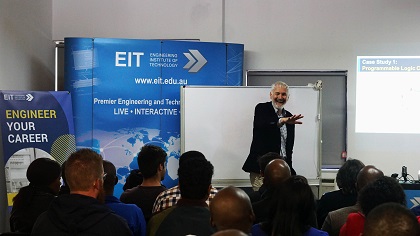
Dr Mackay told the crowd, “you are here to find out how to skill yourself, improve yourself, and constantly refine yourself. Automation is going to accelerate. At the same time, the world is hyper-connected. We are doing everything on our phones these days. It is a quickly changing world.”
Dr Mackay delved into how the traditional STEM (Science, Technology, Engineering, and Mathematics) was lacking a vital ‘E’ which is seemingly missing in engineering graduates around the world. When asking the crowd what the missing ‘E’ might be, suggestions included ‘Ethics,’ and ‘Environment’ which the Dean agreed with, but ultimately defined the other missing ‘E’ as Entrepreneurship.
“There is downward pressure on jobs in developing countries like South Africa,” he said.
“The skills required to prosper are changing, but students have to take initiative as well. There is nothing like experience. My father used to say that no matter how good a design engineer you are, you are nothing until the first electrician picks up a screwdriver on a project that you designed.”
Dr Mackay concluded by saying that universities and colleges are in a period of transformation because of the trends that have arisen due to technological advancement. Qualifications and curricula of the past seem to be slinking into obscurity. Institutions will have to ensure their students have both work experience and theoretical knowledge.
“In the next ten years, universities will be judged on how many of their graduates ended up getting jobs,” he said.
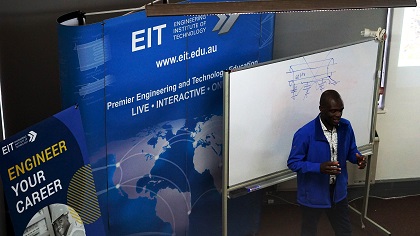
The EIT Ambassador of the Year 2018, Tatenda Nherera shared his experience at EIT with the crowd. Tatenda is an EIT graduate who obtained his 52684WA - Advanced Diploma in Electrical and Instrumentation (E&I) Engineering for Gas and Oil Facilities and Bachelor of Science (Industrial Automation) with EIT.
“In my course, I could remain employed and still study part-time,” he said.
“The studies gave me more meaningful skills, and help me to contribute to my community, where engineering skills like mine are very scarce.
“After finishing my studies, I went to the Engineering Council of South Africa (ECSA) and asked them to examine my results from EIT. They granted me the title of Candidate Technician based on my results.”
To conclude the seminar, EIT’s International Education Manager for the regions of Africa and South America, David Gadjus, took to the podium to highlight the different pathways prospective engineers could take to unlock their engineering careers.
“We run our programs online, but we also have two campuses in Perth and Melbourne where you can relocate to, to come and study,” he said.
“Some of our qualifications are internationally endorsed, and covered by the Sydney Accord, the Washington Accord or the Dublin Accord.”
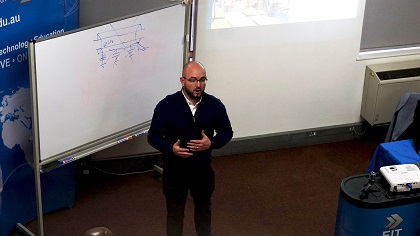
He also explained the many short courses that EIT delivers for engineering practitioners. These, Gadjus said, might expose technologists and engineers to new engineering industries, or further develop their skills in the industry they are employed in.
The seminar proved massively successful in summing up the general feeling among engineers in South Africa; new skills are required to meet the needs of the fourth industrial revolution as repetitive jobs are being phased out.
New engineering trends are creating new engineering jobs, and EIT is at the forefront of providing higher education for students in this ‘new world.’
- Details
- Written by: Edwina Ross
On 22 July, Dr. Steve Mackay, Dean of Engineering at Engineering Institute of Technology (EIT), spent the day at the Tshwane University of Technology (TUT), in Pretoria, South Africa. Engineering staff from universities around the country had gathered for a seminar.
Steve was delighted to also welcome two Engineering Council of South Africa (ECSA) representatives, the President, Mr Cyril Vuyani Gamede and Mr Edmund Nxumalo, Executive Research, Policy and Standards (ERPS).
The universities in South Africa often reach capacity and are obliged to turn large numbers of students away. An online option would allow them to be more inclusive and it could better serve students who live remotely.
Since 2008, EIT has employed a live, interactive online platform of learning, to reach students in over 140 countries around the world. It was the technical tools which underpin this approach to learning that were showcased by Steve, and his colleague from EIT’s IT Department, James Mackay.
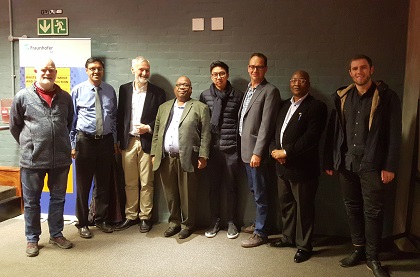
The web-conferencing software — which enables the live, interactive sessions — and the student learning management system were both demonstrated.
They also presented the EIT-designed proctoring software. Without this form of invigilation, it would be impossible to check the veracity of examinations completed by students online; it has proved itself even more eagle-eyed than human invigilators.
Another critical aspect of the platform scrutinised closely by all attendees, were the virtual and remote laboratories which connect to real equipment. These practical applications make online education a truly viable approach to learning in engineering.
- Details
- Written by: Elyse Simich
By now, I’m sure you’ve all heard plenty about the fourth industrial revolution (i4.0) and how technology has the potential to create jobs we previously never dreamed about.
Some commentators have taken a pessimistic view on its potential impact on jobs, with the Australian governments’ productivity commission estimating 40% of jobs could be digitally disrupted in the next 10-15 years.
Interestingly, the Australian Industrial Transformation Institute estimates the level of disruption to be much lower at 5-10%.

However, a joint report from JP Morgan and the Institute for Public Policy Research discusses how such figures only take into consideration disruption to current jobs and not the creation of new jobs.
Report contributor Diane Coyle from the University of Manchester suggests, “Technological progress accounts for the vast majority of long-term economic growth, [so] we should welcome automation.
“Investment in new capital will enhance labor productivity and ultimately improve living standards.
“As citizens of aging countries with slow population growth and a lackluster productivity record, Europeans should be embracing the robots: we will need them to pay our pensions and perhaps even to care for us.”
Taking this a step further, the Future of Jobs Survey 2018 from the World Economic Forum (WEF) indicates that automation could lead to a net gain of 50 million jobs globally. They estimate that while 75 million jobs may be displaced by advances in technology, another 133 million new roles could be created.
It is important to note what these jobs are likely to be.
The WEF’s report goes on to list jobs that are likely to remain stable, and the fields in which more jobs are expected to be created in by 2022.
Job roles that should experience growth are; process automation specialists, innovation professionals, big data specialists, AI and Machine Learning specialists, robotic specialists and engineers, digital transformation specialists, big data analysts, e-commerce, marketing and social media specialists, and IT specialists.
The WEF predicts the top skills required by 2022 will include analytical thinking, innovation, problem-solving, creativity, technology design and programming, critical thinking, leadership, systems analysis, and emotional intelligence.
This means developing both hard (technical) skills and soft skills is imperative for future-proofing yourself to keep up with the changing workforce.
On the other hand, it is expected that skills such as manual dexterity, financial management, reading, writing and mathematics, personnel management, time management, and quality control, will become increasingly redundant as technology begins to automate these processes.
In response, the WEF suggests it is important that engineers start focusing on upskilling in areas that will be at the forefront of the future workforce; “Workers with in-demand skills ready for augmentation may see their wages and job quality increase considerably.
“Conversely, even if automation only affects a subset of the tasks within their job role, workers lacking appropriate skills to adapt to new technologies and move on to higher value tasks may see their wages and job quality suppressed by technology steadily eroding the value of their job, as it encroaches on the tasks required to perform it.”
Researchers from Edith Cowan University and Flinders University have collaborated on an article in The Conversation, where they discuss the jobs of the future. The article suggests the vocational education and training (VET) sector needs to increase its collaboration between industry, educators, and governments to ensure students graduate with relevant skills.
More interestingly, they write that educational institutes need, “responsiveness and flexibility in delivering skills, from formal qualifications to micro-credentials or non-formal education to reflect the needs of rapidly changing technologies.”
The Engineering Institute of Technology (EIT) has been at the forefront of engaging industry to create technologically relevant qualifications and professional development courses that ensure students graduate with the skills required to succeed in the workforce.
EIT’s Dean of Engineering Steve Mackay emphatically believes that automation will preserve the engineer, as long as he or she takes part in meaningful professional development.
“The most important message is that you should commit to continuous professional development,” he said.
“Look for the job demands of the country you are based in and be open to opportunities to learn and skill up. Every country needs particular engineering skills - in fact - every town has its own particular demands.”
You can learn more about EIT’s professional development courses and our school of industrial automation on our website. Our interactive, online delivery mode means you can gain new skills and knowledge from anywhere in the world while working full-time.
- Details
- Written by: Quintus Potgieter
The traditional engineering qualification is going through changes. Universities and technical vocational educational institutions are coming to grips with the changing nature of engineering. The world’s problems need solving, and they cannot be solved with one engineer from one discipline from one university anymore.
Some universities and institutions understand that, and are determined to bridge the gaps between engineering disciplines. Other universities do not seem to grasp the idea of changing educational offerings at all - and produce future-proof-less engineers.
With technology advancing at a rapid rate, universities are having to update their curricula with the most cutting edge research and technical information. What universities are wanting to do is instruct the prospective engineers in the kinds of knowledge that can help them help the world.
One subindustry engineering has produced is the assistive technologies industry. This is an industry that sees engineers developing technologies for disabled and elderly people in hopes that it might make their lives easier. The industry has heated up to such an extent that entire degrees are being compiled.

There are over one billion people living with a disability. Accessibility to technology is thus extremely important.
The universities that are meeting this challenge head on are the University College London (UCL), Loughborough University London and the London College of Fashion. They have just added the Master of Science in Disability, Design and Innovation to their offerings. It will be a multidisciplinary approach to creating assistive technologies. The curriculum is ready to go, with expert instructors ready to teach, at the Global Disability Innovation Hub (GDI) based at the Queen Elizabeth Olympic Park.
The GDI Hub is pumping £10 million that will see the Life Changing Assistive Technology For All programme reach over 3 million people.
Dr Catherine Holloway, Academic Director of the GDI Hub told Eureka Magazine:
“The global potential for disability innovation is huge. New technologies provide opportunities for scalability and access, but to accelerate this movement we need a new generation pioneers. The Disability, Design and Innovation Masters is the world’s first course in this rapidly growing area of expertise. Students will be taught in a uniquely multidisciplinary environment, learning from global experts, live research projects and high-profile global collaborations. We’re looking for exceptional students with the drive and determination to push the boundaries of this new area of study.”
The market is ripe for some innovation in the tech sector for the specific task of creating truly innovative technologies for the disabled and the elderly. As a result, engineering startup companies with budding engineering entrepreneurs have been developing to get them to the market.
Even big tech is getting in on the game. Google has gotten its engineers to develop a subtitling function to its new operating system Android Q. It will be very helpful to hard of hearing and fully deaf people when activated on the smartphone. The function named Live Caption can transcribe podcasts, videos, audio and even video chat on the fly, as it happens. It is accessible via one tap.
The MSc in Disability, Design and Innovation has modules on entrepreneurship, engineering skills and understanding of the global policy and societal contexts of disability. Consequently, the industry could see more software and hardware entering the world that will positively assist those with disabilities.
Works Cited
“Google's Impressive Live Caption Will Add Subtitles to Any Audio on Your Phone.” Android Authority, 7 May 2019, www.androidauthority.com/google-live-caption-983562/.
Ucl. “Disability, Design and Innovation MSc.” UCL Graduate Degrees, 11 Feb. 2019, www.ucl.ac.uk/prospective-students/graduate/taught-degrees/disability-design-innovation-msc.
- Details
- Written by: Quintus Potgieter
On a mild autumn day on the 26th of April 2019, the Engineering Institute of Technology hosted a seminar in Midrand, South Africa. Inquisitive, prospective engineers gathered to learn how EIT’s unique Australian qualifications, which are driven by industry, can transform engineering careers.
Dr Steve Mackay, Dean of Engineering, streamed in from Australia to introduce the session and respond to some questions. He spoke of EIT’s academic pathways which can be accessed by students directly from school or by artisans and tradesmen and women. He explained how students graduate as engineering technologists and then, if desired, professional engineers. The Dean also spoke of his belief in the power of automation in our modern era. He said:
“Your studies, your job, your career, and your life will be changed by automation. This is where EIT and you come into the picture. We are in a hyper-connected world. Everything is becoming software driven, and we are bringing engineering education into that realm and into this globally digital world. We are in the Fourth Industrial Revolution. We can see it in action, and we want students to get the necessary skills required for the technologies defining the oncoming industries of the future.”

Steve stated that technologies, and the fusion of technologies, are impacting the planet across first and third world economies. And EIT’s International Education Manager for the regions of Africa and South America, David Gadjus, went further, explaining how industrial automation is transforming engineering across all disciplines and across the globe. He also drew on his experiences travelling across the continents, saying:
“Some people ask if engineering is a dead-end. Categorically not, engineers have always been in demand. Even in the bad times, even when there is a recession. You will never really look back. The only challenge is that you must keep building on your knowledge and career; there are a huge number of jobs we do not even know about yet. We have to grab the opportunities by the horns.”
One of EIT’s Course Advisors, Kamohelo Tsotetsi, gave clarity at the seminar on the several Accords that EIT has acquired and which formalise the global relevance of EIT’s qualifications. He said:
“We have courses accredited under the Dublin, Sydney and Washington Accords. We are an institution that allows you to - while you are working and gaining experience in industry - study towards your future career goals. Alternatively, if you are just graduating from school, you can apply to join our Bachelor degrees. There are options and pathways to unlocking your future - and we are here to help.”

David Gadjus rounded off the seminar by espousing EIT’s on-campus studies in Australia. It is another option for eligible South African students, for those who would prefer to study abroad. EIT delivers five higher education qualifications on-campus in Perth, Western Australia:
- Master of Engineering (Industrial Automation)
- Bachelor of Science (Mechanical Engineering)
- Bachelor of Science (Industrial Automation Engineering)
- Bachelor of Science (Electrical Engineering)
- Bachelor of Science (Civil and Structural Engineering)
The attendees at the seminar were intrigued by the prospect of acquiring Australian qualifications in engineering whether studying from home in South Africa, using EIT’s live and interactive online platform of learning, or on-campus in Australia.
With South Africa being a moment away from an election, job creation, the Fourth Industrial Revolution and skills development are hot topics.
Are you looking to work your way up towards a rewarding and mobile career in Engineering? Or do you require professional development in an already established career? Enquire about EIT’s diverse range of online courses and the on-campus degrees that are available today.
- Details
- Written by: Quintus Potgieter
Students at the Durban University of Technology (DUT) and at the Technical Vocational Educational and Training (TVET) institutions in South Africa are facing a horror situation at the beginning of their academic year.
At DUT some of the students are responsible. Their protests have been followed by vigorous retaliation from private security and have resulted in the shutting down of the institutions.
Students at the Durban University of Technology (DUT) have protested at the living conditions in their accommodation and also at the shortage of it. On the 5th of February, one of the twenty-year old students was killed by a private security guard; this forced the protests into overdrive.

The students have charged the National Student Financial Aid Scheme (NSFAS) with conspiring with DUT to defraud funds. They believe The NSFAS allocates thousands of rands to the university, for its student accommodation, but then squeezes eight or nine of them into apartments designed realistically for three.
The students say they could find much better accommodation if they were given access to the money themselves.
The accommodation troubles go further: DUT has accommodation available for 13,000 students, but has a student population numbering 30,000.
To alleviate this DUT is reportedly paying the landlords of apartments, in the surrounding town, to evict tenants. According to investigative journalism program, Carte Blanche, tenants who have lived in those apartments for decades are being given eviction notices to make way for the incoming students. The landlords reportedly agree to marginally renovate the apartments and then accommodate 8 students in a single apartment.
Sadly, apart from the student uprising, crime is also on the rise around the DUT campus. Women in particular say they do not feel safe.
Five of DUT’s campuses have suspended their academic programs due to a stalemate in conversation between the management and the student representative council headed up by the Economic Freedom Fighters (EFF).
To make matters worse for students in South Africa, in the more northern city of Pretoria, members of the National Education, Health and Allied Workers’ Union (Nehawu) have gone on strike citing ‘horrible working conditions’. They also made mention of low salaries and useless pension benefits. The strike meant that lecturers linked with the unions would effectively ‘down tools’ and not teach students in the TVET sector.
Workers from 50 TVET colleges were involved in the strike. Nehawu vowed to shut down all TVET and CET colleges around the country.
International standard
South Africa simply seems unable to sustain the TVET colleges they have. Constant shutdowns and general maladministration is stifling the academic progress of prospective technologists and future engineers.
Student leadership of the African National Congress believes that TVET college qualifications should be recognized as equal to university degrees. And yet at TVET colleges lecturers are striking and rebuffing professional development which does not bode well for the system.
Badly resourced and with a dwindling pool of skilled lecturers the TVET colleges are not only hindering their students, but also the country; South Africa and the South African economy desperately need able, vocationally trained graduates.
There are alternatives, of course, and one of them is the Engineering Institute of Technology (EIT). South African students can acquire Australian qualifications via a live and interactive platform of learning, from home.
EIT offers Bachelor of Science degrees (in 4 engineering fields), (and Master degrees) and a host of Advanced Diplomas. Away from the potentially disruptive elements of a campus and the scramble for accommodation students can attain a high quality qualification, accredited by the Australian Government, from the safety and comfort of their own homes.
EIT’s mission is to prepare students for work in the fields of engineering and technology. The technology used in the online learning platform enables learners to practice the theory they learn and they receive industry-driven content from an international team of engineering experts, who teach live online. There are also supported by dedicated Learning Support Officers throughout their studies.
The schools of engineering at EIT include:
- Data Communications and Industrial IT
- Industrial Automation, Instrumentation and Process Control
- Electrical Engineering
- Mechanical Engineering
- Civil Engineering
- Electronic Engineering
- Engineering Management
Visit the website and enquire today!
Works Cited
“Carte Blanche.” YouTube, YouTube, www.youtube.com/channel/UCW67mIQxNQ3G2AHffz8Bvvw/videos.
Ncobela, Stanley. “TVET Colleges Need Serious Attention from Government.” SowetanLIVE, Sunday World, www.sowetanlive.co.za/opinion/columnists/2019-02-14-tvet-colleges-need-serious-attention-from-government/.
- Details
- Written by: Quintus Potgieter
Artificial Intelligence may be the key to empowering rural education and ensuring a future where no students get left behind.
At least that's what venture capitalist Kai-Fu Lee believes.
The momentum behind Artificial Intelligence does not seem to be slowing down. Some of the biggest companies in the world are utilizing it: Google, Amazon, Facebook, Tesla.
According to Kai-Fu Lee, the best place to capitalize on AI is China. It's there that he is known as the Oracle of AI. He is also a former employee of Google, Apple, and Microsoft.
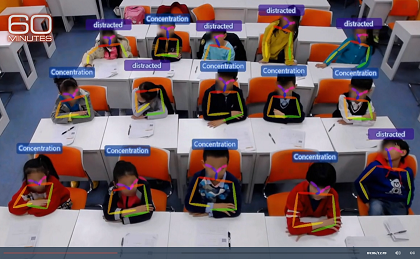
Speaking to CBS' 60 minutes, he said most people around the world have no idea how quickly AI is advancing.
"I believe it's going to change the world more than anything in the history of mankind. More than electricity.”
He has funded 140 AI start-ups. His Beijing venture capital firm has supported approximately ten one-billion-dollar companies.
In 2017, China's technology markets received half of the global AI capital.
One of the major areas of AI emerging from China is recognition technology. This technology scans images and CCTV footage to identify everyday objects, as well as people.
As it turns out, Chinese educators have found a place for AI recognition systems in education.
TAL Education Group is investing in technology that detects emotions on human faces to determine their feelings. They tutor five million Chinese students across the country.
The beauty of this software is that it can pinpoint students who look lost or confused, so the teacher realizes they need extra attention. It can also pick out students who are gifted.
"It can also create a student profile and know where the student got stuck, so the teacher can personalize the areas where the students need help," said Kai-Fu Lee.
Another one of his projects is the designing of software that sees some of the top teachers in China broadcast via the Internet to students in one of the most impoverished schools.
In 2010, approximately 70 million children in rural China were left behind by their parents, who were pursuing high-paying jobs.
Often these children are poor academic performers due to the lack of premium educational institutions in their rural communities. Most of these students don't make it past ninth grade.
According to a study entitled ‘China’s Rural Education: Chinese Migrant Children and Left-Behind Children,' the separation between child and parent has ‘substantial adverse effects on these youth's development.'
Kai-Fu Lee said he hopes this new technology can give these children the same opportunities he had when he moved from Taiwan to the US.
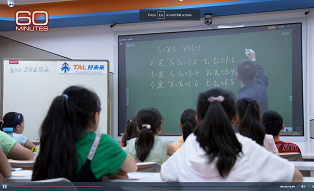
"When I arrived in Tennessee, my principal took every lunch to teach me English. And that is the kind of attention that I've not been used to growing up in Asia. And I felt that the American classrooms are smaller, encouraged individual thinking, critical thinking. And I felt it was the best thing that ever happened to me."
This experience has led him to employ dozens of engineers to create education platforms to deliver the same quality of education he was privileged enough to receive.
The Internet has created the opportunity for educational institutions to broadcast their premium educators and content into rural communities.
In this way, AI could transform the education market.
However, while AI may be a game-changer for the education sector, its effect on jobs — if left unchecked — could be catastrophic.
Kai-Fu Lee believes up to 40% of the world's employment could be displaced as AI overtakes repetitive jobs.
"Chauffeurs, truck drivers anyone who does driving for a living their jobs will be disrupted more in the 15 to 20-year time frame and many jobs that seem a little bit complex, chef, waiter, a lot of things will become automated we'll have automated stores, automated restaurants," he said.
But, it isn't all doom and gloom. Lee believes that society will make the necessary plans to circumnavigate the adverse effects of automation. He concluded:
"Well, in some sense there is the human wisdom that always overcomes these technology revolutions. The invention of the steam engine, the sewing machine, electricity, have all displaced jobs. And we've gotten over it. The challenge of AI is this 40 percent, whether it is 15 or 25 years, is coming faster than the previous revolutions."
Works Cited
“Facial and Emotional Recognition; How One Man Is Advancing Artificial Intelligence.” CBS News, CBS Interactive, www.cbsnews.com/news/60-minutes-ai-facial-and-emotional-recognition-how-one-man-is-advancing-artificial-intelligence/.
Lisa Yiu & Luo Yun (2017) China’s Rural Education: Chinese Migrant Children and Left-Behind Children, Chinese Education & Society, 50:4, 307-314, DOI: 10.1080/10611932.2017.1382128
- Details
- Written by: Quintus Potgieter
The Engineering Institute of Technology visited Kathmandu in Nepal, meeting with students and families in the area to encourage ongoing engineering education and skills development. Nepal is a landlocked country in South Asia and is located mainly in the Himalayas. It has an estimated population of 26.4 million people. It is the 48th largest country by population in the world.
In December, the Nepali Times published an article entitled: The Science of Learning. It highlighted the need for Nepalese schools to ‘add STEM (Science, Technology, Engineering, Mathematics)-based instruction to prepare the country for the future.’

The country wants to prioritize STEM education, so graduates with a good grasp of technologies can use their skills to improve Nepal. Experts are asking for government strategies to be implemented urgently, to better STEM education.
EIT wants to meet those STEM-empowered school leavers the minute they journey into higher education. EIT International Education Agent Coordinator, Caroline Mackay, and International Recruitment Manager, Rolf Baum, visited the nation's capital, Kathmandu, in November. Mackay, who had just recently begun working in the education industry, said:
“It was my first trip to Nepal. It is a beautiful country with a rich culture, incredible mountain ranges as well as friendly and welcoming locals.”
In Kathmandu, the pair conducted mini training sessions and student seminars at education agent offices around the city. EIT organized a seminar at the Hotel Annapurna that saw a great turn out. Baum said:
“The emerging middle-class Nepalese family continues to grow year on year. With the increased population and lack of infrastructure to cater for educating their daughters and sons within Nepal, international education is seen as a priority, and Australia continues to be the destination of choice.”
Instead of just providing general programs to the region, EIT is looking to offer more courses that are focused on the kinds of knowledge explicitly needed for Nepalese students. Baum said:
“Having visited Nepal numerous times during the last ten years for this industry where the focus has been on the promotion and recruitment of general programs for the Vocational and Higher Education sectors, our recent trip provided a refreshing opportunity to now position a high quality set of programs in a specific discipline that is in demand.”

A seminar was also organized for EIT’s Nepalese students and their families, giving them an idea of what courses are available for distance learning in Nepal, or on-campus learning in Australia. The seminars also saw some of EIT’s already-studying students meeting with the team. Mackay said:
“I love how friendly and welcoming each person is. It was also amazing to meet our partners; we at EIT have been working with them over the past two years, but until my trip we had not met face-to-face.”
Baum also fondly recapped the seminar, talking about meeting some of EIT’s students and witnessing the prospective graduates coming together and celebrating how EIT trains and educates engineering professionals. He said:
“This was set up to be informal, and we were privileged to host one of our Nepalese Master's student’s families that included his wife, mother, father, and grandfather. At our presentation, the student spoke in Nepalese about his time at EIT. It was wonderful to watch the family’s proud reaction.”
At the mini sessions and seminars hosted by EIT, there was a significant focus on Industrial Automation. Videos, discussion forums, and presentations were conducted, showing the Nepalese students the rapid changes occurring in the engineering industry and inspiring them to keep their skills up to date for the ongoing fourth industrial revolution.
EIT presents students with an invaluable opportunity to obtain a globally relevant qualification that can lead to real employment. Encouragingly, the uptake of these engineering courses is enabling EIT to see the gaps in education in Nepal, that EIT can fill. Baum said:
“We identified an opportunity for EIT to consider introducing an on-campus Masters of Civil and Structural as there were many enquiries for this program with the increasing development of Nepal.”
Interested in learning more about EIT’s programs? Please refer to our website: https://oncampus.eit.edu.au/
Works Cited
Kandel, Prakriti. “The Science of Learning.” Nepali Times, www.nepalitimes.com/here-now/the-science-of-learning/.
- Details
- Written by: Quintus Potgieter
The Australian government is favouring universities and neglecting the vocational training sector. This is according to recent reports issued by the Australian Industry Group (AI Group). They charge the government with funding bias.
The AI Group says that tertiary education is “seriously unbalanced, has no coherent policy and lacks a universal funding framework”.
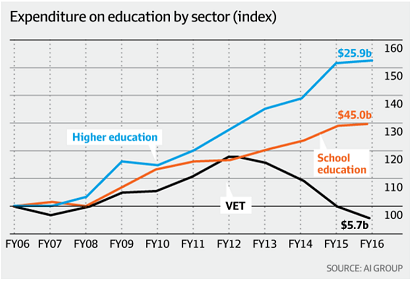
AI Group chief executive Innes Willox indicated that funding for qualifications heavily favours universities. He says that the vocational educational training funding has “fallen off a cliff”.
AI Group reported that spending on universities ‘went from $17 billion in 2006 to $25.9 billion in 2016’, whereas spending on vocational training has been reduced from ‘$5.9 billion to $5.7 billion’. Willox has previously said:
“It’s a case of different but unequal. There is a perception that the training sector is ‘lower’ than the university system because of the status of the jobs the sector serves. If the Australian economy is to prosper and remain internationally competitive, it is vital to have access to a highly skilled and qualified workforce. With the rapid advance of technology and digitalisation, a higher level of skills for the workforce is more important than ever.”
And despite the funding inequity he told media:
“The higher education system is not fit for purpose. There’s a real concern among employers that we’re reaching a crisis point in having an available stock of students with knowledge they need.”
The lack of funding seems to be related to the declining perception of the sector and has resulted in what the AI Group feels are low numbers: 1.6 million vocational training students in Australia.
The Australian Industry Group also put out their CEO Business Prospects Survey. They surveyed national CEOs, finding that optimism was hard to find for 2019.
The 2019 Australian federal election is coming up and the hope is that the incoming government will prioritize what is best for education and training institutions across Australia. The AI Group says that the tertiary education system ‘requires comprehensive policy overhaul’. Willox concludes:
“The VET sector is in need of immediate attention in this area. In this context, demand-driven funding models need to be retained but improved to be more equitable than existing practice.”
Furthermore, the report clamours for workplace learning to be recognized as a component of tertiary education in future. Universities are filling their classes with students, and teaching the appropriate amount of theory, but once graduates are produced, their workplace skills and ability is highly questionable. AI Group says the qualifications’ structure in Australia ‘needs to be reviewed’ in order to welcome micro-degrees and the kinds of vocational training courses that teach skills.
Works Cited
“'Seriously Unbalanced': AiGroup Slams University Bias in Training.” Financial Review, Financial Review, 31 Jan. 2019, www.afr.com/news/policy/education/seriously-unbalanced-aigroup-slams-university-bias-in-training-20190131-h1aofz.
“Media Releases.” Australian Industry Group, www.aigroup.com.au/policy-and-research/mediacentre/releases/.
- Details
- Written by: Edwina Ross
The Engineering Institute of Technology was delighted to welcome representatives from the Universiti Putra Malaysia, on the 29th October 2018.
The delegation was made up of a wonderfully enthusiastic group of ten students, the university’s principal, Dr B.T. Hang Tuah Baharudin, and the students’ chaperone.
For an education provider dedicated to engineering we are conscious of the need to lure females to this largely male-dominated industry. It was very exciting, therefore, to meet these ten visiting students, all of whom were women!
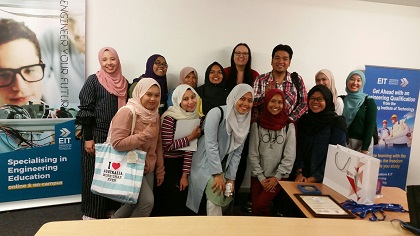
Over a morning tea the students were welcomed to EIT by the Compliance and Accreditation Manager, Ms Caroline Patterson. She gave them an overview of the college and proudly encouraged them to visit Perth’s beautiful sites while here.
The visitors then gave short presentations. Each student outlined her study focus and career dreams, post-graduation, in engineering.
Thereafter Mr Paul Celenza, the College Manager, provided the students with an insight into EIT’s unique approach to engineering education. He explained how engineering experts from around the world reach and teach EIT students in 146 countries, using a live online approach.
The visitors were fascinated when Paul recalled the story of an EIT student (and scientist), who was able to continue his studies while working in Antarctica!
Mr James Theodosiadis (Engineer, Lecturer, Laboratory Coordinator) gave the visitors a taste of the remote labs (connected to real equipment), the virtual labs and the simulations that EIT students access for their practical applications. The visiting students enjoyed that they shared, with James, the same engineering vernacular.
Dr Milind Siddpura, Learning Support Officer and Lecturer, then welcomed the students onto the EIT campus. He outlined the blended form of learning used for our on-campus students.
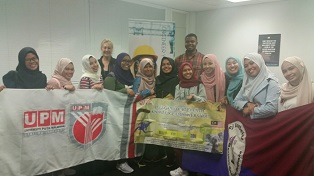
Back row: Ms Miriam Munitz, (in charge of EIT Student Services)
and Mr Victor Onoja, EIT Master student and Academic Assistant
At the end of the day the Malaysian students were put to work! Mr Victor Onoja, a Master student at EIT and Academic Assistant, had them participate in a maths evaluation quiz. They were excited by the opportunity and their confidence (as they illustrated their solutions on the board) was well-founded; they all did exceptionally well.
Our visitors were extremely appreciative of EIT’s hospitality and demonstrated this with a range of lovely gifts.
All of us here at the Engineering Institute of Technology wish our Malaysian visiting students everything of the best in their studies. We know that they will indeed make impressive engineers in time, ably contributing to their Malaysian communities.
- Details
- Written by: Quintus Potgieter
Global Engineering organizations have created cross-cultural spaces wherein all races, religions, and personality types coexist. And with more first world countries looking to take their engineering education and training beyond their borders, the meeting of cultures will increasingly occur. Today it doesn’t matter who you are or where you’re from, if you have the knack for engineering you can be educated and trained up to a global spec.
As early as the turn of the millennium, the year 2000, the Auckland University of Technology’s Faculty of Science and Engineering foresaw the trend; a mix of cultures, working together and creating the kinds of technologies we have observed over the last 18 years.

Professor John Buckeridge, from the university’s Faculty of Science and Engineering, wrote a report entitled, ‘The Y2K Imperative: The Globalisation of Engineering Education’. It highlights that with the establishment of the Washington Accord, in 1988, real multi-cultural Engineering began. The Accord was an agreement signed by the professional engineering bodies of Australia, Canada, Eire, Great Britain, New Zealand and the United States of America. Not long afterwards, China and South Africa became signatories.
Buckeridge said that the signing of the Accord began a shift in the Engineering industry. He writes:
“The net result has been a partial inter-nationalisation of the profession, such that appropriately qualified members of one Professional Engineering Institution be admitted, upon application, to the relevant grade of membership of another Institution within the Accord without further examination or interview.”
Since then multiculturalism in Engineering has burgeoned. Now the world is quite literally the prospective Engineer’s oyster. Globally, students can study an online course, get a globally recognized qualification and work in many countries or thrive in their own. The mobile engineer may have to face some cultural challenges, but nothing that cannot be turned into a positive if he/she is well-prepared.
Cultural literacy
It is not unusual to see engineers travelling internationally for work; in fact some do so with such regularity that they become ‘culturally literate’.
Someone who understands cultural literacy, because of the research she has conducted into it, is American author, Professor Erin Meyer. She has written a book entitled, ‘The Culture Map: Breaking through the Invisible Boundaries of Global Business’. In a lecture on the topic she reflected on some of her cultural missteps doing business around the world. She said:
“I was on a trip to Japan with a Japanese colleague. I gave a short presentation to a group of Japanese participants, and at the end of the presentation I asked them if they had any questions. No one raised a hand so I went to sit down.”
Erin’s Japanese colleague whispered to her that there were questions and proceeded to single out one person who did indeed ask a question.
Perplexed, Erin asked her colleague to explain. Apparently it was to do with “how bright their eyes were.”
“In Japan, we don’t make as much direct eye contact as you do in the West. So, when you ask people if they have any questions, most people are not looking at you directly. But, a few people in the audience are looking directly at you, and their eyes are bright. And that indicates that they would be comfortable with you calling on them.”
The Japanese describe someone’s shortcomings in social interactions as ‘Kuuki Yomenai’, or ‘KY’. The term is used to describe someone who is unable to read a situation or unable to pick up the mood of a conversation. Thus, a Westerner may be guilty of not - as the Japanese put it - ‘reading the air’ well enough.
In her book, Erin has designed a pattern of dealing with different cultures in different multicultural spaces. She said:
“We divided culture up into different types of behaviors and we started looking at things like, how is trust built in different parts of the world, how do we make decisions differently in different parts of the world, and we saw that we were able to come up with patterns for how countries or cultures felt differently on those scales.”
Engineers, and students of engineering, should take advantage of every opportunity to interact with people who are culturally diverse. Be open to their differences and be prepared to learn their customs. This is an approach that will go a long way to ensuring their success as engineers of the world.
Works Cited
Google Scholar Citations, Google, scholar.google.co.za/scholar_url?url=https://www.researchgate.net/profile/John_Buckeridge/publication/237128581_A_Y2K_Imperative_the_Globalisation_of_Engineering_Education/links/02e7e535878d81fb51000000.pdf&hl=en&sa=X&scisig=AAGBfm1vN_1l-DwiGED2DM_oQmDMxSh3-w&nossl=1&oi=scholarr.
“Business Speaker Erin Meyer: How Cultural Differences Affect Business.” YouTube, 10 Dec. 2014, youtu.be/zQvqDv4vbEg.
- Details
- Written by: Quintus Potgieter
Paul Celenza is the College Manager at the Engineering Institute of Technology (EIT); he has worked for the college for eight years. Upon a recent visit to South Africa, Paul reflected on eight years of change and innovation in the education sector and revealed more about EIT’s novel approach to the future of engineering education and training
EIT’s sister company, IDC Technologies, began offering courses to students over 25 years ago; short engineering professional development courses, on site and in classrooms around the world – a branch of the business which still exists today.
With the reach of the internet and emerging online technologies EIT began offering these short certificate courses online. The platform is live and interactive and provides students, in all corners of the world, with access to engineering and technical training. The college also now awards Australian qualifications in a range of diplomas, advanced diplomas, BSc and Master degrees for those in, or heading into, the technology and engineering industries.
These qualifications have been designed by EIT with teams from industry, to ensure the content is relevant and driven by the demands in industry. Celenza says the college has been able to nimbly adjust its offerings to keep up with the changing nature of technology:
“Traditional engineering is morphing. Some positions in industry are becoming more niched, whereas others require a range of engineering disciplines. The education behind these professions needs to change as the technology changes.”

For example one of the college’s signature degrees is the Bachelor of Science in Industrial Automation Engineering. Apart from covering the specific technologies relating to it, it incorporates mechanical and electrical engineering; it provides students with the requisite skills for a profession which is critical to the fourth industrial revolution.
Celenza commented further:
“The whole world is talking about STEM - we want to facilitate student careers in technology and engineering across the globe.”
EIT already reaches students in over 140 countries, but felt a campus would benefit school leavers. To this end the first EIT campus opened in Perth, Western Australia in February this year. Students passionate about engineering and technology, from Australia and abroad are being welcomed. The on campus learning is blended, using EIT’s local and international lecturers; academics and engineering experts from industry.
The Commonwealth Register of Institutions and Courses for Overseas Students (CRICOS) makes the process of bringing students into Australia possible. Higher education institutions and their unique course are listed in the register, and international students are encouraged to apply. Celenza said:
“Our first intake has been small, which is good – we have learned much from this band of learners; they have encouraged us to expand in Perth and open others in Australia and abroad. With all that EIT offers, we are really building the hybrid college of the future.”
Paul spearheads the recruitment of students in the VET (Vocational Education and Training) sector of EIT - where all training is delivered online. This option to study online, for those working full time and with family commitments, is a massive advantage to students. The need to do further study has become increasingly important in our fast-paced world and the online platform of learning is the facilitator.
In the VET courses and higher education degrees EIT ensures all content is designed with the demands of the workplace in mind and it is continuously improved. Celenza explains:
“Universities, with mammoth campuses, often teach obsolete skills to students. They graduate with little or no practical work experience; it becomes lost in the academic world. Students with access to hands-on experience which is underpinned by technology translates into more valuable, employable workers.”
EIT, Celenza says, is consolidating and improving all of the technological requirements of a modern day education and training institution. They are providing their students with remote labs that can be accessed from all over the world and creating virtual simulation canvasses for students to experiment on.

Furthermore, the institution is utilizing a new, novel, cloud-based approach to student management. Celenza’s recent trip to South Africa, from EIT’s Australian head office was motivated by this. He was tasked with guiding the institutions’ Learning Support Officers (LSOs) through the technological processes of upgrading their student management framework.
EIT, on the road to 2020, is in a consolidation phase of strengthening their offerings in both the VET and higher education sectors - steadily building the foundation of future learning so that they can be the futuristic institution that modern day students are seeking.
Paul notes that as a College Manager he comes into contact with EIT students from many cultures, from all over the world. He admits proudly that he provides support to many of these learners who are determined to improve their employability and their lives through gaining qualifications via a globally relevant institution.
- Details
- Written by: Quintus Potgieter
The validity of any engineering education and training institution lies in the accreditation of its courses. An ongoing mission for qualification boards around the world is to find providers that are truly educating and training up to spec, and to flag those which are problematic.
Technological advancement has enabled education providers to reassess and rejig their approaches to education; with the advent of the internet, new learning platforms have emerged. But still, recognition and accreditation reign supreme.

The number of students that can be reached when learning online is far greater (even when a synchronous or live approach is used). Students who struggle to access a campus can now acquire qualifications. Better still, online learning is impervious to strikes on campus which threaten the running of classes and the platform is usually robust enough to cope with small or large intakes (the size of the ‘lecture theatre’ online is much more flexible).
An event that made a strong case for online learning was the Fees Must Fall movement in South Africa. It was a nationwide protest for tuition-free universities; a significant disruption to academic progress around the country. The movement lasted from October 2015 to October 2016.
During that time universities relied on their online portals and other virtual platforms. Both the University of Witwatersrand and the University of Pretoria reportedly ran efficient online modules that enabled engineering students to continue their studies undisrupted, but remotely.
An institution which has a well-established synchronous online learning platform is the Engineering Institute of Technology (EIT). For a good ten years now South African students have been acquiring their engineering qualifications through EIT. Interestingly, after the disruptions at South African universities, the interest in online study and training has grown tenfold.
Achieving recognition
As far back as 2014 the South African Qualifications Authority (SAQA) began recognizing EIT’s Advanced Diploma of Industrial Automation at NQF Level 6 - a level equivalent to the National Diploma in South Africa.
It was a good sign that international qualifications could obtain official accreditation in South Africa. With high numbers of unskilled and unemployed young people, and spiraling attrition rates within their education institutions the country needs solid, safe education options for students of engineering and technology.
The Engineering Council of South Africa (ECSA) has taken a magnifying glass to online institutions intent on educating and training South African students. They have shown much interest in the interactive online learning model EIT provides.
Recently South African, Kevin Tatenda Nherera, graduated from EIT’s online Advanced Diploma of Electrical and Instrumentation Engineering for Oil and Gas Facilities. He has been recognized as a Candidate Technician by ECSA.
This has resulted in a hopeful and positive outlook for online education and training. There is an indication that those courses, previously denied accreditation by the authorities in South Africa, may be legitimized in the near future.
Online institutions must, however, ensure their delivery platforms are engaging and encourage students to continue through to graduation. Attrition rates tend to be far higher when courses are delivered asynchronously.
The Dean of Engineering at the Engineering Institute of Technology, Dr Steve Mackay, has been on the forefront of gaining accreditation for online modules, but is a fierce advocate for the relationship between lecturer and student, claiming that an online platform should not impede this. He said:
“My suggestion is to avoid asynchronous online education. Attend courses where instructors and students meet in real time, via video conferencing or web conferencing. This is synchronous online learning; the type of inflexible online learning that drives students to complete their qualifications.”
He goes on to add:
“I am very pleased that our learning platform has also enabled us to offer BSc degrees in Engineering online, to both school leavers and to advanced diploma holders. With the added option to study on campus in Australia”
- Details
- Written by: Quintus Potgieter
Mulweli Yolanda Mafukata went from a high school nestled away on a farm, to studying towards a career in engineering in a big city. On the 8th of January 2018, she tweeted an image of herself on-site, wearing a hard hat, high visibility vest, and a pair of robust boots.
Her tweet read: “What a man can do, so can a woman”. It provides the world with a window into the life of a modern South African engineering student. She had been tasked with collecting samples from a coal processing plant - samples that were to be analyzed in a coal laboratory.
Back in 2013 the Engineering Council of South Africa revealed that only 4% of engineers in the country were women. This story is therefore heartening - Mulweli serves as a working example of what South African, school-leaving, female students can aspire to.
The school years
Mulweli’s interest in engineering slowly developed during her secondary education years. She explained: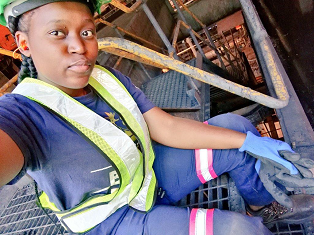
“Like many children in South Africa who are exposed to very few career paths, I wanted to be a medical doctor and save lives as a child. I grew up as a very bright and confident learner through my primary and high school years. I did my high school in a farm boarding school in the outskirts of the Limpopo province. My main subjects were mathematics, physical sciences, agricultural sciences and life sciences.”
During high school, Mulweli discovered that she had an affinity for physical sciences and mathematics, but less of an appetite for biology. That was when she settled on becoming an engineer.
She matriculated in 2013, earning distinctions in all her subjects. She was also the top performer in Agricultural Science in the Limpopo province of South Africa. Exxaro, a South African mining company, awarded her a bursary.
Going to University
She is currently studying towards her Bachelor in Engineering in Chemical Engineering at the University of Pretoria. She is in the fourth year of a five year program. Mulweli believed that this field of engineering would maximize her chances of being employed in the engineering world. She explains:
“One of the main reasons why I chose chemical engineering is because of the flexibility it presents me with. It does not confine me to just one niche or industry. A chemical engineer can find a role in mining, food, medical, environmental, business, banks, and in research industries. I am fascinated with how engineers are able to take something as useless as used cooking oil and use it in the making of biodiesel on a commercial site. Energy is a big interest to a chemical engineer and if we can use what we have to get more energy... I think we are winning then.”
Because of the discipline’s breadth she says it has been a challenging degree. Mulweli says her modules have covered a “bit of electricity, a bit of drawing, mechanics of materials, and a lot of programming”.
She is a shining example of how a previously male-dominated industry in South Africa (and indeed the world) is becoming more gender inclusive. Mulweli believes that without women engineering workplaces would be depriving themselves of great minds and unique ideas that could solve critical engineering problems.
Mulweli thinks that some women are turned off by the ‘hard-hat’ lifestyle that sometimes typifies engineering. She commented:
“Women should be made aware that although there will be some dirty work, an engineer’s job is mostly strategic planning, calculating, solving problems, designing, and optimisation of processes...and also managing people. An engineer is someone who can sit down and solve a problem by just looking at the numbers and applying all the knowledge obtained over the years.”
It is clear that Mulweli is enterprising, but to her great credit, her ambition encompasses a highly developed social conscience too. Mulweli explains:
“My dream is to get to a position where I can use my chemical engineering degree in an entrepreneurial way to make money and to also help other people.”
- Details
- Written by: Quintus Potgieter
There is a toy revolution occurring. A renewed, concerted effort is underway to make toys for children and young adults, to condition their minds in preparation for the world of STEM (Science, Technology, Engineering and Mathematics).
Schools are implementing STEM programs which involve classroom renovations that are stimulating, but fun. For some time now too many students have been losing interest in science and maths, even before they reach high school, making it very difficult for them to rediscover a love for these later on. This not only limits their employment prospects, but leaves them without the excitement that STEM disciplines promise throughout their lives.
Primary schools are making a concerted effort to mitigate this slide. Robotics and innovative problem solving technologies, designed to cognitively challenge students, are creeping into classrooms. To ensure that this occurs around the world (even in the most rural areas), the technologies and learning equipment employed need to be as affordable as possible.
Nintendo has been showcasing what the future of STEM-inspired fun can encompass. Their new innovation utilizes one of the most cost-effective, most abundant materials known to man: cardboard.
Nintendo’s latest console, the Nintendo Switch, is a favorite amongst youths who are pressuring their parents to buy it. And it just got cooler. Nintendo has launched ‘Labo’; - it includes foldable cardboard sheets that interconnect with the gaming console.
The user folds the cardboard (DIY fashion) and connects it to the console controllers so that it can be used to play the games on the 6.2 inch screen.
Nintendo’s console has motion-sensing technology built in, making the cardboard interfacing even more fun. For instance users can fold together (in an almost origami fashion) a cardboard steering column and play a racing game on it.
The company has also introduced a robot suit, RC car, piano and fishing rod – all made out of cardboard and rubber bands.
Nintendo is hoping its new cardboard range will become tools that will spur kids to pursue STEM subjects later on in their academic lives.
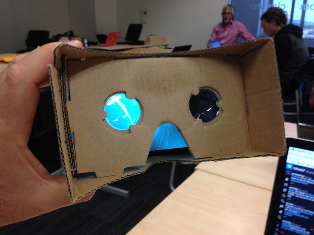
Cardboard simulation technologies seem to be a marker for where the education and training industry is heading. Just a few years ago, companies were releasing cardboard virtual reality goggles with cheap lenses. It was a glimpse into the future of virtual reality. Since then, virtual and augmented reality headsets have taken off in a big way.
The only problem with Nintendo’s Labo? The price. Their Variety Kit costs US$69.99, and the Robot Kit costs US$79.99. Some parents will find this prohibitive. Nonetheless, if foldable cardboard toys that interface with technology become a focus for stimulating children in the fields of STEM, lower prices for similar technologies must follow.
Works Cited
Horaczek, Stan. “Nintendo's Labo Cardboard STEM Toys Are a Recycling Bin Full of Fun.” Popular Science, 2 Feb. 2018, www.popsci.com/nintendo-labo-stem-toy-impressions#page-3.
- Details
- Written by: Quintus Potgieter
The United Kingdom is between a rock and a hard place in the lead up to exiting the European Union. One of the concerns is that with a hard Brexit, EU students may not form part of the makeup of engineering professionals in the country’s future. Thus, more British-born students are being encouraged to pursue STEM (Science, Technology, Engineering, Mathematics) qualifications.
The Prime Minister of the UK, Theresa May, has used reverse-psychology to encourage more students to invest in STEM qualifications rather than in the humanities. The plan includes making arts studies cheaper than more STEM-focused qualifications. Essentially, she wants to devalue the arts.

The government will suggest that majoring in the arts may lead to ‘lower earning potential’ for students, whereas STEM degrees offer higher monthly salaried jobs. These suggested revisions are part of May’s current university ‘overhaul’ plan - a plan she is hoping may provide England’s students with improved education.
Nicky Morgan, a former education secretary, talking to the Evening Standard doesn’t believe devaluing BA degrees is a good one. She said:
“We want everybody to feel that all careers are open to them. If those who are struggling to afford university in the first place feel they cannot do a STEM degree because it is too expensive, ultimately it is the country that will suffer.”
Alongside this students in the United Kingdom are demanding that the government provides free education - a call that has been echoing in many universities around the world. Fees for courses in the UK can reach a maximum of £9,250 per year (US$ 12,866), with interest rates of 6.1% on any student loans. UK universities are among the most expensive in the world, next to the United States.
Putting arts into engineering
Qualification costs aside – there is an interesting push to embed the arts into engineering education. Among other benefits, such as improved communication skills, there is the belief that the arts may well enhance engineering designs.
Océane Boulais was the Hispanic Professional Engineering’s Extreme Engineer of the Year in 2014. Giving a TEDx Talk in 2015, she used Leonardo Da Vinci, Albert Einstein and Steve Jobs as examples of minds who expertly crafted artistic elements into engineering and scientific elements.
She is an advocate of putting the A in STEM: Science, Technology, Engineering, Arts, Mathematics.
She too highlights the fact that liberal arts qualifications get little funding compared to STEM qualifications. Yet, if STEAM-focused creators such as Da Vinci, Einstein, and Jobs created some of the most renowned products, then liberal arts should be more respected in STEM qualifications, Boulais argues.
Works Cited
“Integrating Art with STEM Education | Océane Boulais | TEDxBocaRaton.” YouTube, 5 May 2015, youtu.be/DjpWQkmopgY.
“Theresa May Warned Cheap Fees for Arts Courses 'Risk Driving Poor Students Away from Science and Tech'.” Evening Standard, 19 Feb. 2018, www.standard.co.uk/news/politics/theresa-may-warned-cheap-fees-for-arts-courses-risk-driving-poor-students-away-from-science-and-tech-a3770291.html.
- Details
- Written by: Quintus Potgieter
The world is still looking for the most effective way of educating and training people. Privately owned universities and institutions are keeping their eyes on initiatives in the business sector.

Universities are looking towards the most efficiently built organizations of the last decade, noticing how they have construed to scale up. With the arrival of the internet and lower cost technologies, institutions have had to formulate new strategies. They have created online platforms for their students, saved money by reducing their dependency on infrastructure and extended their reach to students who are based around the world.
Tim Dodd, the Higher Education Editor for the Australian newspaper, says universities are following the Uber-model when it comes to transformation. He writes:
“Does this business model remind you of anything? To me it smacks of Uber or Airbnb, companies with no physical assets but enticing enough to consumers to dominate their sectors. So here’s the question. Are we entering the age of the Uber-university?”
Even investment companies are conceding that Uber, as a case study, has made them rethink how they provide their services to customers. Uber’s business model has led them to be the most profitable taxi service in the world. (They originally did not own the cars, but now have engineers designing automated vehicles that are self-driving.)
Many universities and institutions are hoping to follow suit; they are realigning their businesses to resemble a zero-cost operation like Uber without the cost of cars.
Business...what is it good for?
Companies are growing in strength and offering services that their founders probably never dreamed they would be offering when they founded their companies. Amazon, for example, is teaming up with Warren Buffett's Berkshire Hathaway and JP Morgan to provide health insurance.
It is not outside of the scope of thinking, therefore, that private companies provide effective education and training which has diverged from its traditional approach.
Salim Ismail, the author of a book named ‘Exponential Organizations: Why new organizations are ten times better, faster, and cheaper than yours (and what to do about it)’, saw the rise of exponential organizations back in 2014.
Ismail asserts in the book that a Fortune 500 company would have typically taken 20 years to be worth a billion dollars, whereas smaller more efficient companies like Uber, have done it in much more quickly. Ismail writes:
“We have entered the age of the billion-dollar startup and soon, the trillion-dollar corporation, where the best companies and institutions will be moving at seemingly light speed. If you haven’t transitioned into an Exponential Organization as well, it will not only seem as though your competition is racing away from you, but also, like Kodak, that you are sliding backwards at breakneck speed into oblivion.”
Closing the gaps in engineering
Universities and educational institutions have historically offered engineering courses that covered a vast and sprawling number of engineering subjects; those they envisioned would be needed in the industry.

However, as technology advances, specifically skilled engineering technologists are often needed quickly. Institutions, therefore, are beginning to offer niche curricula so that industries can be fed specialized professionals more speedily. In a traditional approach an undergraduate and specialized postgraduate degree would have been needed.
With engineering requiring hands-on skills some have cast doubt on an approach to learning which involves an online platform. Tim Dodd disagrees. He writes:
“Yet, even here, it’s amazing what practical skills students can learn using virtual reality devices linked to smart learning software. This means that in courses where it is necessary to have face-to-face interaction with students, it doesn’t necessarily require all the physical infrastructure found in today’s university campuses.”
Works Cited
Ismail, Salim, et al. Exponential Organizations: Why New Organizations Are Ten Times Better, Faster, and Cheaper than Yours (and What to Do about It). Diversion Books, 2014.
Theaustralian.com.au. (2018). [online] Available at: https://www.theaustralian.com.au/higher-education/costsaving-pressures-create-a-place-for-uberversity-model/news-story/d39eee8f62fbab46c73b66b314646c5f [Accessed 14 Feb. 2018].
- Details
- Written by: Quintus Potgieter
The future is yours for the taking.
This good ole’ adage has driven many into PANIC MODE; there is undue stress for young people when it comes to picking a vocation.
 A fresh batch of school-leavers have just begun their academic year and many will have chosen the discipline of engineering – they will be wondering which field of engineering will best suit them and provide them with good job prospects.
A fresh batch of school-leavers have just begun their academic year and many will have chosen the discipline of engineering – they will be wondering which field of engineering will best suit them and provide them with good job prospects.
Engineering graduates should reassure these undergraduates with the following advice: find your way into engineering education and focus on establishing a ‘broad scope’ of skills necessary for working in interdisciplinary industries.
School-leavers and prospective engineers and technologists are facing a new reality: they may find jobs in engineering industries they were not expecting to get into. And many will change direction during their careers or become more proficient in a field of engineering that they did not study.
Some school students believe that the science and math they learn at school will define the engineering streams they select and the jobs they get. Whilst the cognitive benefits of grasping high school math and science are advantageous, the reality is that the science and math that graduates end up grappling with in their engineering careers may be wholly different.
One degree, plenty choices
Perhaps there are some engineering courses that have more variety and versatility than others. An alleged engineer on social media site Reddit, ‘abadonn’, thinks Mechanical Engineering provides a pathway into many different industries. He writes:
“Mechanical engineering. It’s probably the broadest of all career choices. We learn a bit of everything: MatSci, EE, Math, Structural, Thermal, Programming, etc. And if you want to specialize you can always go get a masters. I work for a large biomed company that probably hires more mechanical engineers than biomedical engineers.”
Some engineers are determined to ‘follow the money’. The biomedical engineering industry is becoming one of the most lucrative engineering industries due to wearables and automation making its way into the industry. These technological developments ensure that many different types of engineering disciplines plug into the biomedical industry. There does, however, need to be a certain amount of caution when selecting a way forward. In many countries a biomedical engineering graduate may only find maintenance work in his/her field, with few opportunities for design.
Engineer + travel = happiness
Engineering can come with travel benefits with – engineers (depending on what and where their credentials have been gained) are often deemed globally relevant to many job markets.
In Australia, at mining companies like Rio Tinto, many engineering professionals form part of a FIFO (fly-in-fly-out) program. Engineers are flown in to work for a stretch of time (accommodation is provided for them), the company then flies them home for a patch of time before they again return to site.
Some engineers opt to immigrate to other countries and take their expertise elsewhere. Some fortunate engineers even take their expertise to Antarctica.
South Africa, for example, has a little known South African National Antarctic Programme. The program is run in conjunction with the South African National Space Agency. Yearly, South African engineers and science professionals descend on Antarctica to assist with Space Weather Research. We talk to an electrical engineer who overwintered at the SANAE IV base in Antarctica:
Engineers with a ‘can do’ attitude, who also want travel benefits, could find themselves in the pound seats. And in many instances, accomplishing life-changing work.
Works Cited
“What Engineering Discipline Did You Specialising in/Are Studying and Why? • r/Engineering.” Reddit, www.reddit.com/r/engineering/comments/wp437/what_engineering_discipline_did_you_specialising/.
- Details
- Written by: Quintus Potgieter
It may be a landmark year for Indian engineering. This year, at the end of March, India’s Space Research Organization (ISRO) will land an unmanned rover on the moon.
They will be sending an orbiter, a lander, and a rover in what it is being called the Chandrayaan-2 mission. Directly translated, using a combination of Sanskrit and Hindi, Chandrayaan means ‘Moon Vehicle’. ISRO has sent an orbiter around the moon before, but eventually lost contact with it.
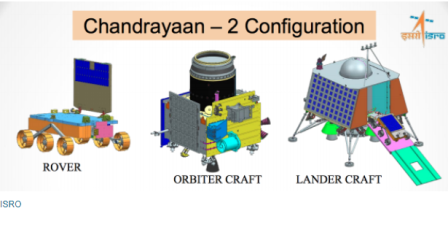
The project’s cost has seen many estimates; some suggest it will be US$93 million, whilst others say US$70 million. For comparison sake, the Chandrayaan-1 mission, which only orbited the moon, cost $83 million in 2008.
Nonetheless, ISRO are hoping to challenge their engineers quite significantly in the next few years; they hope to launch a satellite on a 5-year journey to study cosmic radiation after their lunar mission.
Engineering education
It was estimated by the International community Empowerment Foundation Monitor that, with China, India would produce 40 percent of global STEM graduates by 2020. However, education experts are reporting that graduates from India are not being ably prepared for the job market.
According to the Deccan Chronicle, 1.5 million engineering graduates are produced in India every year, but more than half of them do not find jobs in the industry. Professor Venkata Gaddam Reddy, an education expert, said:
“About 80 percent of engineering graduates are not employable because of poor quality, shortage of quality faculty, inadequate funds and infrastructure, lack of practical training or industry internships and no research activities.”
Varun Aggarwal, co-founder of Aspiring Minds (an online psychometric and aptitude testing company), and author of the book ‘Leading Science and Technology: India Next?’ agrees that India lacks engineering research role models. He told Economic Times India:
“While the government is emphasizing the need to build focus on research and development for gaining competitive edge on the global forefront, there are very few scientists and researchers who emerge as public role models.”
These revelations were highlighted in a new study that revealed that only 3 in 10 engineering graduates from India have any knowledge of international researchers or research journals in their field of study. Students reported that engineering course curricula did not truly align with the practical requirements of the engineering industry.
The government in India is trying to stymie the creation of new engineering colleges. They have encouraged the All India Council for Technical Education (AICTE) to prevent new engineering colleges from being approved in 2018; there are very low attendance figures in the technical courses that already exist.
What remains clear is if India wants well-qualified engineers that can continue to develop spacecraft for their space organization and for their engineering industries generally; they have to solve the current crisis in their engineering education and training.
Works Cited
“China and India to Produce 40% of Global Graduates by 2020.” ICEF Monitor - Market Intelligence for International Student Recruitment, 14 Jan. 2016, monitor.icef.com/2012/07/china-and-india-to-produce-40-of-global-graduates-by-2020/.
“Engineering Graduates Have Poor Awareness of Research: Study.” The Economic Times, 29 Jan. 2018, economictimes.indiatimes.com/jobs/engineering-graduates-have-poor-awareness-of-research-study/articleshow/62700657.cms.
Puppala, Anusha. “Hyderabad: Engineering Overhyped; Quality Takes a Beating.” Https://Www.deccanchronicle.com/, Deccan Chronicle, 28 Jan. 2018, www.deccanchronicle.com/nation/current-affairs/290118/hyderabad-engineering-overhyped-quality-takes-a-beating.html.
- Details
- Written by: Quintus Potgieter
Online education is rapidly innovating. Education traditionalists may have thought that if courses were to ever go online those without labs would be the first - never did they anticipate that engineering courses might beat the arts to this platform that crosses borders.
Colleges and their online offerings are growing in number; both practitioners and students now have a little more choice and flexibility.
There is also a growing preponderance of shorter courses in the market place, in more niched topics.
Udacity, for example, is an institution that provides online courses and nanodegrees. It has just announced their ‘Flying Cars & Autonomous Flight’ nanodegree.
The course’s landing page - on the Udacity website - details what students will learn during the nanodegree. They promote the following skills, “master autonomous flight software engineering skills”, “drone robotics” and “sophisticated flying car systems”. The students will also learn to write real code for real aircraft.
SpaceX and Tesla CEO, Elon Musk, has been reticent about suggesting that flying cars are the future. He has called them a ‘safety disaster’. In an interview with Bloomberg Business, he said: “Obviously I like flying things, but it’s difficult to imagine the flying car becoming a scalable solution. If somebody doesn’t maintain their flying car, it could drop a hubcap and guillotine you.”
Nonetheless, Udacity’s course deals with cutting-edge drone technology and software that is currently a reality. Students will be well-equipped if they do ever need to test the feasibility of flying cars one day. The tuition for the course is $2,400.
Udacity is just one of many institutions that are providing engineering education across the globe, via the internet. Engineering education is going online because the technology that allows it is here, and that technology is becoming more sophisticated all the time. The Internet of Things (IoT) also facilitates students’ applied learning when they study online.
The Engineering Institute of Technology
The Engineering Institute of Technology is an engineering education provider that began in the classroom, but has, over the years, developed a successful live, online platform of learning. Once upon a time their lecturers flew all over the world for physical workshops, but now the internationally-based lecturers reach EIT students in over 140 countries without moving from their home offices.
EIT has come full circle – they have just opened a new campus in Perth, Western Australia. But they are taking the interactive, online platform that they have built and honed, implementing elements of it into the classroom environment. Mackay says:
“Our qualifications are all offered online. But we now have a campus in Perth, Western Australia, where we will be applying the online model in the classroom. The lecturers will be all over the world, streaming into the classroom. We will also be working with local teachers and lecturers, physically in the classroom. Most importantly, our focus is on the digital world.”
Mackay says EIT is very happy to have their first cohort of students on their campus starting this February. He says that EIT will partner students with further education as their careers change and mature. This is the pattern for many already - EIT’s academic pathways move seamlessly from diplomas and advanced diplomas through to BSc and Master degrees.
Works Cited
Chafkin, Max. “Elon Musk Is Really Boring.” Bloomberg.com, Bloomberg, 16 Feb. 2017, www.bloomberg.com/news/features/2017-02-16/elon-musk-is-really-boring.
“Flying Cars and Autonomous Flight.” Udacity, www.udacity.com/course/flying-car-nanodegree--nd787.
- Details
- Written by: Quintus Potgieter
Online learning is continuously morphing as education industries try to find the best practice in educating and training students across the globe. With technologies enabling new methods of learning many brick-and-mortar institutions are losing traction.
Kevin Carey, an Ohio State University Masters graduate, published a book in 2015 named The End of College: Creating the Future of Learning. He believes that in the future, thanks to technological developments, the university will be everywhere and available to everyone. An excerpt of his book reads:
“These students will be educated in digital learning environments of unprecedented sophistication. The University of Everywhere will solve the basic problem that has bedeviled universities since they were first invented over a millennium ago: how to provide a personalized, individual education to large numbers of people at a reasonable price. The intense tutorial education that has historically been the province of kings and princes will be available to anyone in the world.”
Carey has a futuristic outlook. The reality, in the current day, is looking a little murkier. For some institutions online learning and on-campus learning are beginning to function in a more hand-in-hand fashion. Institutions are, for example, creating more value by delivering their online learning content on-campus as well.
Feel around in the dark
The questions of whether or not a fully online learning system could replace colleges and universities in the future have been lingering for many years. Even some of the top institutions who have incredibly efficient online platforms are still experimenting with what works and what doesn’t.
For example, Daphne Koller, the President and co-founder of Coursera - a world renowned online learning platform - answered the question on whether or not colleges would become obsolete on the Q&A website, Quora. She said:
“There will always be demand for face-to-face discussion with professors and peers, and for the other activities and services that universities provide to on-campus students. Technology can, however, replace some of the less personal, less specialized work that on-campus instructors are doing today - grading basic assignments, delivering big lectures, etc. At many Coursera partner institutions, professors are beginning to use their online courses to deliver some of this core content to their on-campus students.”
Koller calls it (what many in the industry are calling) the ‘flipped classroom’ or ‘blended learning’ approach to teaching university students; where much of the instructional content is provided to students outside of the classroom. She goes on to say:
“For some students, traditional higher education is simply cost-prohibitive; others may have existing careers, family commitments, or other responsibilities that prevent them from participating in a program full time; still others may have physical or mental disabilities that make learning in a classroom impossible.”
However, artificial intelligence, computing technology, augmented and virtual reality technologies, and more, may just present further challenges to keeping the doors open at some colleges and universities. Technology is transforming more quickly than most institutions can. Students’ ability to learn outside of the classroom/lecture hall is already a reality.
Carey explains the future of educational institutions will be defined by the personalization the institution can provide to the student. He writes:
“That personalization will be driven by advances in artificial intelligence and fueled by massive amounts of educational data. Information about student learning will be used to continually adapt and improve people’s educational experience based on their unique strengths, needs, flaws, and aspirations.”
Education institutions have to be nimble; they must keep a beady eye on the future, but still tip their caps to the past if they are to provide current students with meaningful learning experiences. And they must brace themselves for new technologies which are doggedly disrupting many industries including their own.
Works Cited
Carey, Kevin. The End of College: Creating the Future of Learning and the University of Everywhere. Riverhead Books, 2016.
In 10-20 years, will traditional college education be obsolete?
https://www.quora.com/In-10-20-years-will-traditional-college-education-be-obsolete
- Details
- Written by: Quintus Potgieter
More jobs, more opportunities, and more money. Western Australia (WA) is a state sighing with relief after it was announced that the economic downturn is turning around.
Engineering industry professionals may find solace in the fact that WA economy is gradually gathering momentum. It is finding its rightful place as a state bursting with resources which are needed here and abroad; a feat requiring talented engineers and technicians.
What happened?
Western Australia saw a mining boom that secured jobs for the state in the last decade. It was inevitably followed by a steep unemployment dip after the completion of the mines. By 2015, hundreds of miners were without jobs, a situation exacerbated by the price of iron ore plummeting. It would become known as the ‘iron ore downturn’.
It was estimated by ABC News, that at the very peak of the mining boom, WA’s mining industry grew to more than AUD120 billion (US$96 billion). Then came the downturn, which lost the mining industry AUD30 billion (US$24 billion).
The state went from having one of the most thriving economies, to one of the worst performing economies in all of Australia.
Turnaround
Fast forward to 2018 and thankfully the economy is turning around. Western Australia’s Deputy Premier, Roger Cook, announced last week that the unemployment rate was improving.
New figures published by the Australian Bureau of Statistics showed that the unemployment rate in Western Australia had reduced from 6.6% to 5.7% in December 2017.
Cook told reporters: “What it’s shown is that since December 2016 we’ve seen growth of almost 40,000 jobs in Western Australia. This is tangible evidence that the West Australian economy is turning in the right direction”.
The most sought after jobs are reportedly in the mining, resources, energy, and construction industries. This is according to ABC’s WA job advertisement statistical research. In fact, miners are again being imported into the state to keep up with the demand.
Cook also confirms that the Public Transport Authority, Metronet, is launching projects that will see jobs created, many of which will be for skilled workers.

Getting the education and training
The Engineering Institute of Technology (EIT) specializes in educating and training engineering industry personnel. They use two learning platforms: the first is their live, interactive approach - this allows students to study (alongside full time work) from anywhere in the world.
Their second platform is the more traditional on-campus approach to learning. For international students looking for a challenge and an adventure this may be particularly appealing. EIT’s campus is in Perth, Western Australia and applications for their July 2018 intakes are now being accepted.
 The engineering qualifications available on campus include four Bachelor of Science degrees; one in Mechanical Engineering, one in Civil and Structural Engineering, one in Industrial Automation and one in Electrical Engineering. There is also a Master of Engineering in Industrial Automation. All these qualifications aim to ensure students become proficient technologists and engineers who are ably prepared for the demands of industry.
The engineering qualifications available on campus include four Bachelor of Science degrees; one in Mechanical Engineering, one in Civil and Structural Engineering, one in Industrial Automation and one in Electrical Engineering. There is also a Master of Engineering in Industrial Automation. All these qualifications aim to ensure students become proficient technologists and engineers who are ably prepared for the demands of industry.
EIT has a range of listed scholarships available for local and international students.
Works Cited
“More than 6000 New Jobs in WA Last Month.” PerthNow, www-perthnow-com-au.cdn.ampproject.org/c/s/www.perthnow.com.au/business/economy/job-figures-show-was-economy-is-turning-for-the-better-deputy-premier-says-ng-b88718370z.amp.
Piesse, Emily. “There's Light at the End of the Tunnel for WA Jobseekers.” ABC News, 19 Sept. 2017, www.abc.net.au/news/2017-09-19/wa-jobs-surge-as-mining-downturn-gives-way-to-green-shoots/8956844.
- Details
- Written by: Amber Allen
Memristor is a word that you are likely to hear more of in the next couple of years. The burgeoning world of the IoT (Internet of Things) is driving the need for wireless connectivity and synchronisation across devices.
Its name is a hybrid of memory and resistor – and its function is just that.
This particular type of electrical component, found in circuits, is able to keep track of the amount of charge that previously flowed through it. Importantly, they are non-volatile, which means they can retain this memory without a constant power source.
So why does it matter? Memristor technology is being harnessed in the rapidly expanding industry of wearables; from smartwatches and fitness bands to the less widespread smart fabrics and smart glasses.
The wearable devices market has a mammoth expected compound annual growth rate (CAGR) of 69.35% during 2017-2021. Companies such as HP, Intel, Micron and Samsung are pioneers of this investment and development.
The efficiency of the memristor, compared to other electrical networks, was put to the test recently at the University of Michigan. Wei Lu, Professor of Electrical Engineering and Computer Science, is on a mission to create a computer that thinks like a human. The main challenge – ensuring the processors perform logic activities at the same time as memory-based activities.
Enter the memristor - it can do both simultaneously. Lu’s network, known as a reservoir computing system, mimics a neural network in the brain with its own version of neurons and synapses.
Until now, training these networks has been the difficult part, with the process often taking days or months and being incredibly expensive. Information is entered into the systems in the form of questions and answers, they are then programmed to produce the correct answer and slowly minimise error rate.
When memristors are involved much of this training becomes obsolete - the reservoir component is included and doesn’t need to be trained at all. Bypassing the training stage will save significant time and money.
To put it to the test Lu and his team used memristors to identify handwritten versions of numerals. The reservoir systems demonstrated an impressive 91% accuracy rate after minimal training. Lu hopes to develop this technology for use in speech recognition and prediction.
Memristors are being further refined and developed as we speak; it may not be long before they are found on our wrists, embedded in our clothes and even in bedsheets.
Sources:
http://whatis.techtarget.com/definition/memristor
https://www.businesswire.com/news/home/20171229005094/en/Global-Memristor-Devices-Market---Analysis-Trends
https://www.sciencedaily.com/releases/2017/12/171222090313.htm
https://www.researchandmarkets.com/research/h7wdgw/global_memristor
- Details
- Written by: Edwina Ross
Because they create solutions and solve problems
Mechanical engineers develop processes and they design and implement the moving parts in a range of industries.
They are needed on all stages of a product, from research and development to design and manufacture, through to installation and final commissioning.

Most industries rely on mechanical systems and therefore mechanical engineering is thought to be one of the most diverse of all engineering disciplines.
There are employment opportunities for Mechanical Engineers in a range of sectors including:
- Aerospace – investigating aircraft failures, for example
- Automotive – improving the self-driving mechanisms in vehicles, for example
- Biomedical – developing a mechanical heart, for example
- Construction – designing the fire sprinkler system for a commercial building, for example
- Manufacturing – automating a factory, for example
- Power – finding innovative uses for coal, wind and tidal flow, for example
- Railway – integrating technology to enhance safety on the trains, for example

Mechanical engineers can also be involved in the management of people, projects and resources.
Mechanical Engineers are very much in demand today and will continue to remain so as we enter the Fourth Industrial Revolution
- Details
- Written by: Edwina Ross
This is a message to EIT students - past, present and future: to those who want to qualify well and to those determined to benefit from their learning experiences generally.
If you are studying with us presently (or have completed your studies) you will understand only too clearly what the challenges are: you are most likely working full time while studying content and concepts which are often difficult and demanding.
As you juggle these competing priorities it is not so surprising that aspects of your studies are relegated to the back burner. Despite this, I am going to encourage you to squeeze everything you can from can from your course. To do this the following two reminders may help.
Firstly, always keep in mind why you chose to embark on the course. Was it to help promote your career? Or broaden your skill base? Was it because you lacked the specific skills that work was demanding from you? Or because you needed some professional development to help you keep pace with the changes in your industry?

Secondly, don’t forget the investment you made, or are making? Not just the financial one, but the one involving your time - an extraordinarily precious commodity.
Feedback from lecturers on student engagement is often heartening. When it isn’t we become concerned. When students are fully engaged in the learning process it is, without a doubt, the key to improving their outcomes and generally results in higher levels of student satisfaction.
One of our longest-serving lecturers, John Lawrence, has adjusted the format of a number of his live webinar sessions in an effort to address this issue. He has found that instead of sticking strictly to his deadline of one hour, his longer sessions include demos and, with the extra time, student interaction becomes a priority. Students are not compelled to stay beyond the hour, but those that do tend to be, says John, “pretty complimentary”.
On the other side of the coin, John has found that students who miss their live webinars (and fail to adequately catch up with the recordings) do poorly in their assignments – often on the practical components. Weakness here, in applied learning, means that the knowledge gained by students remains largely theoretical – negating the true intention of EIT qualifications.
There is another important factor that contributes to the learning experience of students and it is one that John urges his learners to remember: “the objective (of studying) is for a greater and keener understanding ...” He is saddened when he realises that a student’s sole purpose is to pass an assignment.
Education is valuable in itself, but we must remember that it can be so much more. Michelle Obama, American lawyer and writer, said about her education:
“Through my education, I didn't just develop skills, I didn't just develop the ability to learn, but I developed confidence.”

To our students past, present and future: we, at the Engineering Institute of Technology wish you everything of the best for 2018. Whenever you have the opportunity to learn - formally or informally - do so actively and engage in it fully.
- Details
- Written by: Evangeline Newby
The conference focus this year: Students, Quality and Success, ran over three days, from the 29th November to the 1st December 2017 and was attended by 800 delegates, of which almost 100 were higher education students.
Steve Mackay, our Dean, and Caroline Patterson, our Compliance and Accreditation Manager, were selected to present their paper entitled: Australia’s first hands-on online engineering master degree. The graduation of our first cohort of Master of Engineering (Industrial Automation) students was deemed significant by the TEQSA presentation selectors.
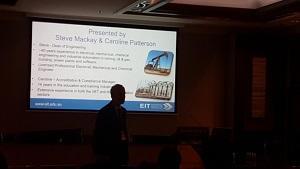
Steve and Caroline’s presentation was, however, also attended by a number of sceptics, “You can’t teach engineering students fully online!”, “How do they get their hands dirty?” Steve explained briefly that the Internet of Things has resulted in the connectivity of engineering tools; a situation which has enabled competent applied learning via remote laboratories and simulation software, as everything is now connected. For many, however, the ‘winds of change’ cause a slightly different form of disquiet; they sense that traditional approaches to learning may be undermined and therefore threaten their jobs too.
Caroline’s presentation was structured around the feedback from the master graduates and our current master students on both the industrial automation and electrical engineering degrees. As part of this she mentioned that a large proportion of students rate online learning more highly than face-to-face. An attendee was astounded and pressed for qualitative support to this assertion.
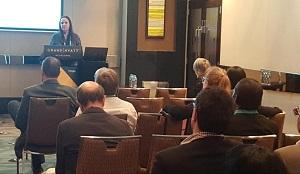
EIT students, past and present (engaged in any EIT program), it would be great to receive your comments. This is how Caroline explained it: she described how the live online platform we use allows for student-lecturer interaction which encourages students to engage in the learning process. She also mentioned that the interaction was less threatening; an increased level of anonymity eliminates the feeling of ‘being put on the spot’. She confidently added that despite the compulsory attendance at the live webinar sessions, the platform meant that both working and remotely-based students were able to acquire a qualification without the upheaval of campus attendance.
Separately Steve expressed enormous pride in the master degree thesis projects that were submitted, commenting on their high standard and relevance to industry. He explained that this was in large part due to the fact that students are working while they study. He admitted that in many ways they have an unfair advantage over students who don’t have this exposure to industry, and indeed, life.
And finally, the audience was able to appreciate the reach of the online platform: apart from our internationally-based lecturing team, our students come from 140 countries. For various reasons there are countries that cannot satisfy student education needs; online learning has resolved this deficiency in many instances. Offering a solution is particularly poignant when we receive word that our graduates, scattered around the world, have been promoted and received salary increases with their qualifications.
Our congratulations and thanks go to our Master degree graduates; we wish you everything of the best. Please keep in touch.
- Details
- Written by: Edwina Ross
The demand for technicians, technologists and engineers in industrial automation, instrumentation and process control is growing rapidly. Why? Because when automation is introduced into industry, production becomes much more efficient and cost effective.
Consider the needs of employees:
- They need training
- They get sick
- They receive wages
- They go home at the end of each day
- They are more productive one day, but less so the following day
Compare this with the needs of control systems - such as computers or robots - and consider the capacity machines have for hard work…….
But Industrial Automation experts ARE needed? The automated systems need to be designed, manufactured, commissioned, calibrated and maintained.
If your students are already in engineering or dreaming of a career in it – they must consider a degree in Industrial Automation!
- Bachelor of Science (Industrial Automation)
- Master of Industrial Automation
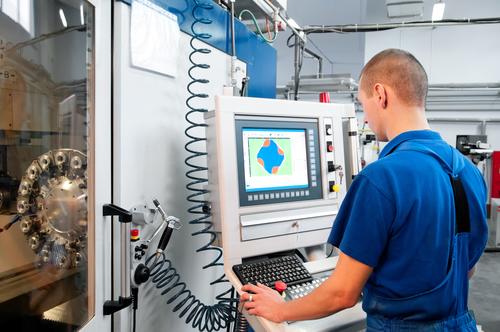
- Details
- Written by: Quintus Potgieter
Higher education institutions were delivered a few body blows last week. Proponents of TAFE (technical and further education) - the leading provider for vocational education and training courses in Australia - delivered the verbal battering.
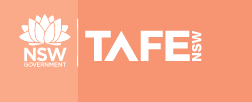
According to ABC News, a number of courses have been cut and campuses closed down, with enrollment figures down by 25 percent as well.
TAFE New South Wales’ Managing Director, Jon Black, asserts that according to Australia’s Productivity Commission’s report, “university students are struggling to find employment relevant to their studies”. He also accused universities of producing more debt for students than TAFE does with their expensive programs.
The New South Wales (NSW) Education Minister, Rob Stokes, responded vigorously to Black’s accusations, saying:
“It is a mistake to talk down the value of universities in a populist attempt to pit the higher education and vocational education sectors against each other. We should be careful not to reduce the value of a university degree to an assessment on whether it prepares a student for one specific job which may not exist in the future.”
What seems clear is that support for TAFE has been waning in the last few years. ABC News reports that in the past 81% of publicly funded students were being taught through a TAFE system, a figure which dropped to 50% by 2015.

Image credit: NSW TAFE
The NSW Labor party has vowed that, if put in the seat of power in the future, a guaranteed 70% of government VET funding will flow back to TAFE. Some online commentators feel that the strain that exists between the two tertiary sectors may persist, but believe that TAFE must be saved for students who are not compatible with university-styled education and content.
No matter the sector, however, one thing is certain: if we fail to nurture a system which prepares students for life and a workplace which is constantly changing, we are failing them and the industries they work in.
Company dissatisfaction is already reflected in the changing of some hiring practices. There are those companies which have begun selecting candidates without regard for academic background. Ernst & Young, for example, have been accepting applicants without formal university education. This shift has everything to do with the realization that graduates are very often ill-prepared for the workplace.
Another issue arising from this emphasis on degrees is outlined by Joshua Krook, a Doctoral Candidate in Law at the University of Adelaide. In a piece for The Conversation, he alludes to the fact that Australia is a country of university degree acquirers. This, he says, forces Australia into a situation where there is rampant underemployment of non-vocational tertiary skilled graduates. He writes:
“Where a bachelor’s degree was sufficient to get a job in research, now a master’s degree is required. Where a master’s degree was sufficient to get a job in university tutoring, now a PhD is required.”
The answer must be a vibrant sector offering industry-driven courses, offered by both TAFE and private vocational institutions. These will ensure students can acquire practical proficiency in sets of skills required by the workforce today and into the future.
Some Twitter users clarify the benefits delivered by the vocational sector:
Twitter user @azza1993 writes:
“I could’ve gone straight to uni for an IT degree. Decided to go to TAFE first and it was second to none for practical experience.”
Another Twitter user named @sewviolets writes:
“Uni has been pushed at the expense of what used to be an excellent TAFE system.”
The vocational institution future
The push (or pull) of students to graduate with degrees is becoming more prevalent around the world. Already, however, there is some awareness that significant skill gaps are emerging and highly qualified graduates are either working in fields unrelated to their studies or finding themselves back at college.
German school leavers seem to have resisted this trend and the UK is addressing it quite vigorously. More recently there has also been a resurgence of technical and vocational institutions in the United States of America; with Trump calling them earlier this year, “the way of the future”. He intends to empower this education sector so that its graduates help reinvigorate the industries that require their more practical skill sets.
Works Cited
Brown, Michelle. “TAFE Hits out at Universities for Higher Debt, Weaker Job Prospects.” ABC News, 25 Oct. 2017, www.abc.net.au/news/2017-10-26/tafe-hits-out-at-uni-over-cost-and-job-prospects/9087252.
Joshua Krook
Doctoral Candidate in Law, University of Adelaide. “Degrees of Separation: Companies Shed Degree Requirements to Promote Merit over Qualifications.” The Conversation, 24 Oct. 2017, theconversation.com/degrees-of-separation-companies-shed-degree-requirements-to-promote-merit-over-qualifications-76150.
- Details
- Written by: Quintus Potgieter
Earlier in the year, the Minister of Higher Education Blade Nzimande survived the cut, however, this time he wasn’t that lucky. The Minister of Higher Education position has been allocated to Prof Hlengiwe Mkhize, the previous minister of Home Affairs.

Image: Former Minister of Higher Education and Training Blade Nzimande
Source: News24
The move by the President further sours the relationship between the members of the once sturdy Tripartite Alliance. The alliance is made up of the African National Congress (the country’s leading party), the Congress of South African Trade Unions (COSATU) and the South African Communist Party (SACP).
The South African Communist Party, of which Blade Nzimande has been the General Secretary in years gone by, has lashed out at President Zuma, saying that the appropriate protocol was not followed with Dr Nzimande’s removal. The SACP were not notified that the shuffle was coming.
The end-of-year exam period in South African universities is one of uncertainty - they have seen protest action from students who demand university fees be lowered in the last two years. Hlengiwe Mkhize, Nzimande’s replacement, has been thrown in the deep end, having to grapple with the reality that there could indeed be more protests this year, as exam time approaches.
Rise of the private institutions?
With the constant shuffling of the heads of higher education departments in South Africa, the training institutions, the budgets that strengthen them and the efficiency of their operations all diminish.
As places of education excellence it is apparent that the public system is facing challenges. Receiving a ‘quality’ education from a department that is constantly returning to square one’ may be a big ask.
And yet South Africa desperately needs competently trained and educated people, including engineering personnel.
The political turmoil in the country is setting the stage for growth in private higher education and training institutions; they will be seen, increasingly, as viable and attractive alternatives.

South Africa should be opening its doors more widely to legitimate, globally operated, higher education and training institutions. With stable education and qualifications of substance available graduates of merit will continue to sustain the growing economy.
Privately-owned institutions that offer synchronous learning experiences via an online framework, with a premium curriculum, will also grow and remain an option for the future of education in South Africa.
The removal of Nzimande, however, causes further concern: private institutions may not get their day in the sun, according to JC-1 ETD Consultants.
JC-1 ETD Consultants is a company which guides private institutions requiring registration with the Department of Higher Education and Training. They also assist them gain accreditation with the Quality Council for Trades and Occupation in South Africa.
They believe that Nzimande was forward-thinking, easing the way for private institutions in terms of gaining the necessary accreditation. They say the removal of Nzimande is similar to “having a head coach replaced from a team that is just achieving success.” In an email to us, addressing the question of how online institutions may change the face of education in South Africa, the company says:
“We believe, that this is an area that can certainly succeed in this country, if not flourish, given the right circumstances. Online services offer learners opportunities where conventional methods requiring time, travel and accommodation often restrict accessibility.”
The South African universities themselves relied on an off-campus, online system of learning when the previous Fees Must Fall protests closed campuses down nationwide. South Africans may find that they have an appetite for e-Learning institutions as the situation worsens. A JC-1 ETD Consultants representative concludes:
“Technological advances offer numerous avenues in which online services can perhaps even better address education and training interventions in certain fields. Newer generations are becoming far more familiar with the use of technology, and with previously less geographically accessible areas, the reach of online education becomes a reality without the logistical problems.”
Sylvia Hammond is the Consulting Editor at Portal Publishing - a leading online publisher in the education and training sector. She too hopes that the department of higher education and training will continue to innovate, so that capable institutions can be established and train the next generation of workers in South Africa. She told us:
“Minister Nzimande brought in the concept of an integrated, articulated post-school system. This provides a framework for school leavers to find the appropriate institute to pursue a career that suits them, and work their way through the various levels of qualification.”
Works Cited
“Zuma Announces Cabinet Reshuffle.” Times LIVE, www.timeslive.co.za/politics/2017-10-17-zuma-announces-cabinet-reshuffle/.
- Details
- Written by: Quintus Potgieter
Cue the X-Files music.
“When it comes to shaping the future, one of the greatest obstacles you have is your mind.”
These were the words of Steve Justice, the Head of the Aerospace Department of the ‘To the Stars Academy of Arts & Science’. Never heard of it? Well, that’s because the academy was launched this year, on the 11th of October, 2017.
The academy is a Public Benefit Corporation headed up by CEO Tom DeLonge. The corporation hopes to globally further science and engineering to the point where science fiction becomes established science fact. If the CEO’s name sounds familiar, it’s because he was a musician in a band named Blink 182.
The corporation has released a video that clarifies their vision and mission:
The group has recruited some interesting, previously top-secret, names.
The aforementioned Steve Justice is recently retired from Lockheed Martin’s Advanced Development Programs - better known as Skunk Works. Justice has 31 years of experience under his belt, developing the kind of aircraft that people may have mistaken for UFOs in the sky at some point or another.
The group touts other professionals that will assist in forging a path ahead for UFO-level science and technology expansion. Other members include:
- A former deputy assistant secretary of Defense for Intelligence.
- A former senior intelligence officer for the CIA
- A former director of programs who investigated unidentified aerial threats
- A group of distinguished physicists
- A geneticist
- A molecular biologist
- And an award-winning storyteller
Transportation propulsion
The group hopes to engineer new propulsion technologies that will rival those in Star Wars. On their website, they say they intend to:
“Develop next-generation aerospace propulsion technologies, using a concept referred to as metric engineering, which uses advanced math modelling techniques, providing a technology base to the Aerospace Division for future products.”
They maintain that ‘beamed energy propulsion launch systems’ and ‘advanced electrogravitic propulsion’ technologies are not outside of modern day engineering’s reach.

Image: The academy’s concept for an international point-to-point transportation craft
Source: To the Stars Academy
Steve Justice, speaking on the group’s Facebook Live said of the academy:
“Today, there’s a generation of people that are not buying cars. They’re using on-demand, point-to-point, transportation within cities. Why have a car? Imagine if that was international. You could go anywhere on the face of the earth in a matter of minutes. So, now you’ve removed that parameter of distance and time that separates us from friends on the other side of the earth.”
These kinds of mind-bending technologies don’t exist yet, or, at least haven’t been made public. The only question that the cynical engineer might ask: Is this technology within our grasp? Justice seems to think so. He said:
“Fifteen years ago, you didn’t know that you needed a smartphone, and now you can’t live without it. The technology that we’re talking about is going to enable a future that is difficult, if not impossible, to comprehend today. We’re setting the stage.”
We could be seeing some of these technologies manifest very soon. Justice confirmed:
“The aerospace division is going to harvest technologies and understanding from the science division - it will try to demonstrate the technologies, build prototypes, and even production systems that can change life as we know it.”
And you could become a shareholder in the company today. You can make your investment in the company by visiting their website: https://dpo.tothestarsacademy.com/.
Technology is evolving at a rapid rate. Landing a rocket after launch was considered beyond human capability and Elon Musk’s engineers and associated experts are developing technologies that some might have considered science fiction years ago. This new academy prioritizes thinking outside of the box, of rethinking technology and of pushing the parameters that limit it. This is probably a good addition to the engineering industry; at the very least it is entertaining.
Works Cited
“To The Stars Academy.” To The Stars Academy, Oct. 2017, dpo.tothestarsacademy.com/.
“Tom DeLonge Launches To The Stars Academy to Explore ‘Outer Edges of Science.’”
Alternative Press, www.altpress.com/news/entry/tom_delonge_to_the_stars_academy
- Details
- Written by: Quintus Potgieter
The future of technology and world class education hinges on the ability of universities to continue to provide a premium higher education experience. Their curricula need to be aligned closely to the demands of the world more than ever before.
 According to University World News, Zimbabwe has warned their universities that they must return to their initial STEM mandates thereby reverting to their cores. By producing STEM professionals the government believes they can help to create wealth in a country which has endured protracted and very difficult economic times. A large chunk of the country’s prosperity depends on how many STEM jobs are being filled.
According to University World News, Zimbabwe has warned their universities that they must return to their initial STEM mandates thereby reverting to their cores. By producing STEM professionals the government believes they can help to create wealth in a country which has endured protracted and very difficult economic times. A large chunk of the country’s prosperity depends on how many STEM jobs are being filled.
The Deputy Minister of Higher and Tertiary Education, Science and Technology of Zimbabwe, Honorable Dr Godfrey Gandawa was quoted by Chronicle, saying:
“We cannot continue to ignore the global trend; there is a need for serious curriculum reform. Students deserve a modern education right now. Instead of a 19th century style, students need modern competences, development of a growth mind-set and a strong character.”
Britain has addressed the need for more STEM professionals; according to the Telegraph, candidates best suited to employers’ demands have increased. In recent years the demand for STEM professionals versus the number of suitable candidates was a ratio of 2:1. The ratio is now 0.90.
Interestingly, the millennial generation: people in their 20s, and 30s are very interested in forming part of STEM industries, whereas the Baby Boomers (those nearing retirement age) are less keen on finding STEM jobs. These revelations came from online jobs classifieds giant, Indeed.
Teachers Wanted
There is a hurdle remaining when it comes to addressing the shortages of STEM professionals around the world. It involves the training and retaining of school teachers who teach STEM subjects ably and in the context of the demands of the real world.
The Scottish government has put together a plan that would offer bursaries to those wishing to be trained as teachers of STEM subjects. These bursaries would total £20,000 each.
 The country is hoping to find 100 bursary candidates a year, thereby budgeting £1 million per year.
The country is hoping to find 100 bursary candidates a year, thereby budgeting £1 million per year.
The Deputy First Minister of Scotland John Swinney said:
“STEM subjects are crucial, not just to the education of our children but the future of the economy. We need to recruit more teachers in these subjects. And to do that, we need to reach beyond recent graduates and attract people who have the appropriate subject degree but are working in business or industry.”
Whether or not the Scottish government’s plans will work, governments are all in agreement: innovative and relevant STEM education (with some stress on entrepreneurial endeavor) and STEM graduates are critical to the growing of the global economy.
Works Cited
Christie, Sophie. “Growing Interest in Science and Engineering Jobs Set to Tackle Britain's Skills Gap.” The Telegraph, Telegraph Media Group, 2017, www.telegraph.co.uk/business/2017/09/19/growing-interest-science-engineering-jobs-set-tackle-britains/.
Macnab, Scott. “Scots Workers to Be Offered £20,000 to Retrain as STEM Teachers.” Politics, The Scotsman, Aug. 2017, www.scotsman.com/news/politics/scots-workers-to-be-offered-20-000-to-retrain-as-stem-teachers-1-4581534.
“STEM: Foundation for a Progressive Future.” The Chronicle, www.chronicle.co.zw/stem-foundation-for-a-progressive-future/.
